Attached files
| file | filename |
|---|---|
| 8-K - FORM 8-K - EXELON GENERATION CO LLC | d8k.htm |
 Morgan Stanley Utilities Conference
March 10, 2011
Exhibit 99.1 |
 2
Forward-Looking Statements
This presentation includes forward-looking statements within the meaning of the
Private Securities Litigation Reform Act of 1995, that are subject to risks
and uncertainties. The factors that could cause actual results to differ
materially from these forward-looking statements include those discussed
herein as well as those discussed in (1) Exelon’s 2010 Annual Report on
Form 10-K in (a) ITEM 1A. Risk Factors, (b) ITEM 7. Management’s
Discussion and Analysis of Financial Condition and Results of Operations and
(c) ITEM 8. Financial Statements and Supplementary Data: Note 18; and (2)
other factors discussed in filings with the Securities and Exchange Commission
(SEC) by Exelon Corporation, Commonwealth Edison Company, PECO Energy
Company and Exelon Generation Company, LLC (Companies). Readers are cautioned
not to place undue reliance on these forward-looking statements, which
apply only as of the date of this presentation. None of the Companies
undertakes any obligation to publicly release any revision to its
forward-looking statements to reflect events or circumstances after the
date of this presentation. This presentation includes references to adjusted
(non-GAAP) operating earnings and non-GAAP cash flows that exclude
the impact of certain factors. We believe that these adjusted
operating
earnings
and
cash
flows
are
representative
of
the
underlying
operational results of the Companies. Please refer to the appendix to this
presentation for a reconciliation of adjusted (non-GAAP) operating
earnings to GAAP earnings. Please refer to the footnotes of the
following slides for a reconciliation of non-GAAP cash flows to GAAP
cash flows. |
 3
Largest merchant nuclear fleet in the U.S.
Consistent world-class performance in nuclear
operations
Utilities serving two of the largest metropolitan areas
in the U.S.
Stable dividend that has yielded ~5% on average
over the past year
Why Is Exelon a Good Investment?
Commitment to investment grade credit ratings and
financial discipline
Exelon is able to execute from a position of strength based on solid
fundamentals |
 4
2011 Events of Interest
Q1
Q2
Q3
Q4
RPM Auction results
(5/13)
Illinois Power Agency
RFP (April)
ALJ Proposed Order
–
DST Rate Case
(3/31)
Procurement RFP
(bids due 5/23;
results by 6/23)
DST Rate Case Final
Order (by 5/31)
EPA Final HAP
Rule (November)
Retirement of Cromby
1 & Eddystone
1 units
(5/31)
Proposed HAP EPA
Regulation (by 3/16)
Procurement RFP
(bids due 9/19;
results by 10/19)
Retirement of
Cromby
2 unit
(12/31)
Proposed 316(b) EPA
Regulation (by 3/14)
EPA Final Transport
Rule (June)
For definition of the EPA regulations referred to on this slide, please see the EPA’s Terms of
Environment (http://www.epa.gov/OCEPAterms/). Note: ALJ = administrative law judge; DST =
delivery service tariff |
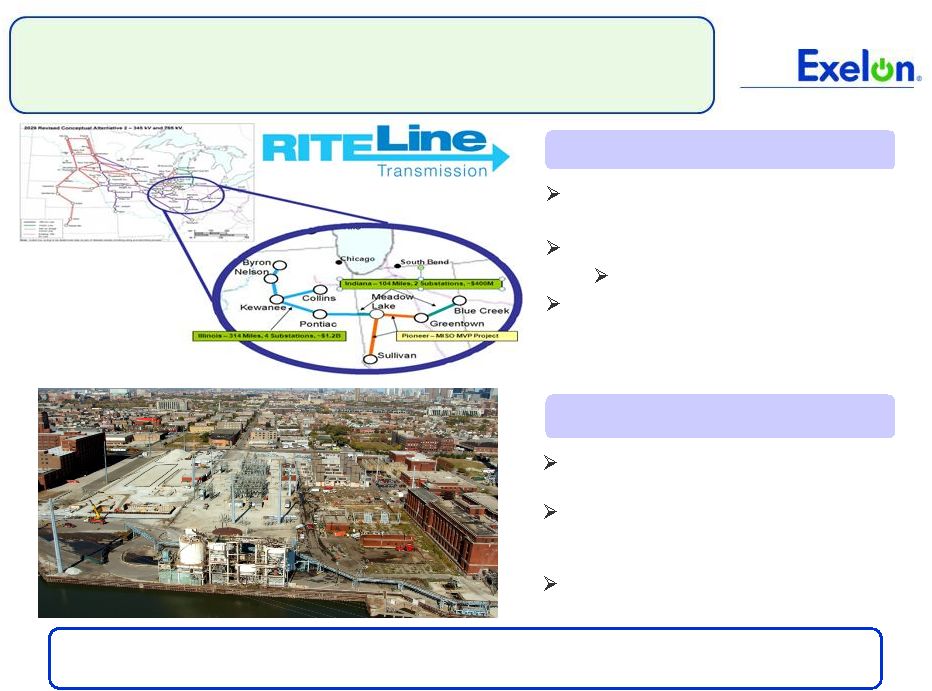 5
5
Pursuing Transmission Investment
Moving forward on project planning
with partner ETA
Total Investment ~$1.6 billion
ComEd/Exelon ~$1.1 billion
FERC incentive rate joint filing
expected late 1Q or early 2Q 2011
Exelon companies are investing in projects that enhance reliability and
support further clean energy development
Note: Electric Transmission America (ETA) is an American Electric Power &
MidAmerican Energy Holdings joint venture company. RITE Line
Enhance reliable service to the
Chicago central business district
Estimated cost of ~$170 million
recoverable under ComEd’s FERC
formula rate
Expected in-service December 2011
West Loop Phase II |
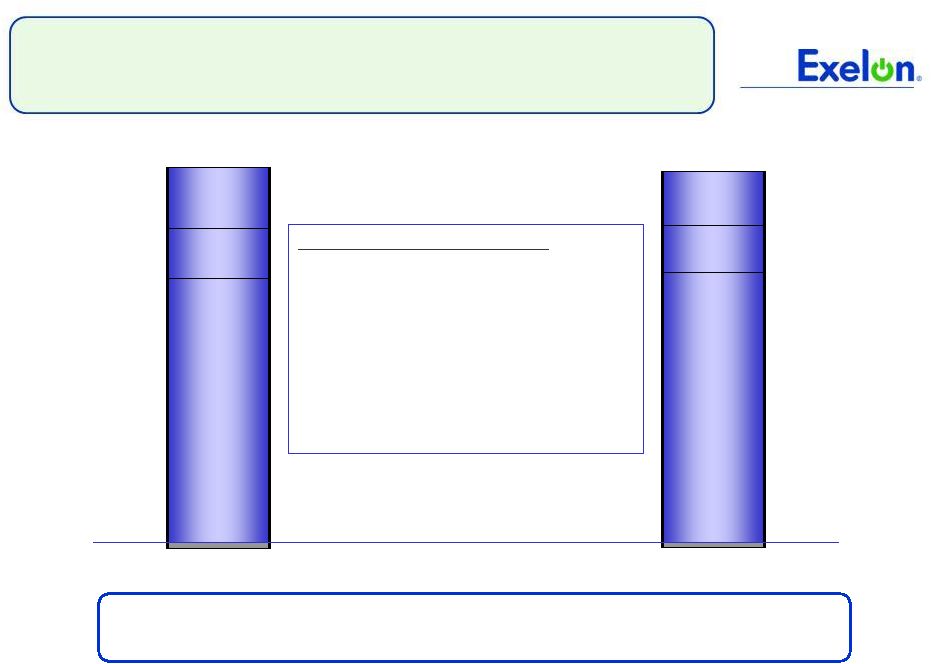 6
2011 Operating Earnings Guidance
2011E
(2)
2010A
$0.54
$2.91
$4.06
(1)
ComEd
PECO
Exelon
Generation
ComEd
PECO
Exelon
Generation
Holdco
Holdco
Exelon
$0.68
Exelon
$3.90 -
$4.20
(1)
$0.55 -
$0.65
$0.50 -
$0.55
$2.85 -
$3.05
(1)
We provided 2011 earnings guidance on January 26, 2011, and we are not updating
earnings guidance at this time. Earnings guidance is only reviewed in connection
with our quarterly earnings announcements or if we expressly indicate that we are
updating the guidance. Refer to slides 45-47 for a reconciliation of adjusted (non-
GAAP) operating earnings
to GAAP earnings.
(2)
Earnings
guidance
for
OpCos
may
not
add
up
to
consolidated
EPS
guidance.
Key Drivers of FY Guidance
+
Generation margins driven by PECO
PPA roll-off, partially offset by lower
capacity revenues
+
Higher PECO gross margin driven by
new distribution rates effective 1/1/11
-
Higher O&M expense
-
Higher depreciation & amortization
expense
2011
operating
earnings
guidance
of
$3.90
–
$4.20/share
and
1Q
2011
guidance
of
$1.00
–
$1.10/share
(1) |
 7
$0.98
$0.68
$2.74
$2.91
$1.07
$0.71
2010A
2011E
PECO
ComEd
ExGen
Operating O&M Outlook
2010 to 2011 Drivers (per share)
Inflation $(0.08)
Full year of Exelon Wind $(0.05)
Two additional nuclear refueling
outages $(0.05)
ComEd
uncollectibles
$(0.04)
Estimated
2011
O&M
represents
a
new
“base”
level
for
operating
O&M
$4.39B
$4.68B
2010 Operating O&M below 2008 levels for second consecutive year
One-time savings in 2010 included executive salary freezes and reduced
compensation benefits
Anticipate annual O&M growth rate of ~2% for 2011-2013
(1)
Amounts
may
not
add
due
to
rounding.
Refer
to
slide
47
for
a
reconciliation
of
GAAP
O&M
to
Operating
O&M.
(1)
(1) |
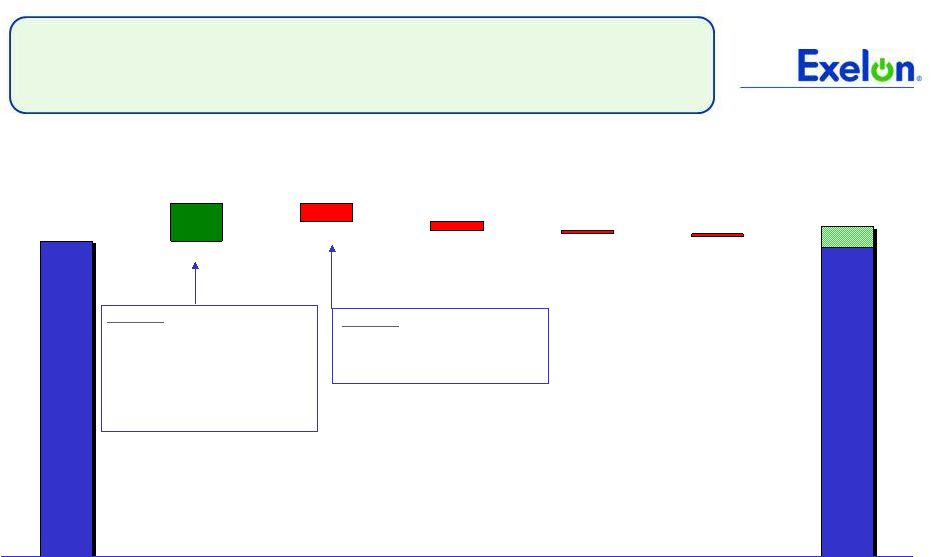 8
Exelon Generation 2011 EPS Contribution
(1)
Estimated contribution to Exelon’s operating earnings guidance.
RNF = revenue net fuel
$ / Share
$0.35
$(0.03)
RNF
O&M
Other
Depreciation &
Amortization
$(0.08)
Key Items:
Inflation
$(0.05)
Exelon
Wind $(0.05)
Nuclear
Outages $(0.05)
2010A
2011E
(1)
$2.85 -
$3.05
$2.91
Key Items:
PECO
PPA
Exelon Wind
Capacity Market Prices
Nuclear Fuel
Market/portfolio conditions
and Exelon Energy
$(0.17)
$(0.03)
Interest
Expense
Note: Drivers add up to mid-point of 2011 EPS range. We
provided 2011 earnings guidance on January 26, 2011, and we are not updating earnings guidance at this time.
Earnings guidance is only reviewed in connection with our quarterly earnings
announcements or if we expressly indicate that we are updating the guidance. Refer to
slides
45-47
for
a
reconciliation
of
adjusted
(non-GAAP)
operating
earnings
to
GAAP
earnings.
$0.62
$0.08
$(0.29)
$(0.09)
$0.07 |
 9
ComEd 2011 EPS Contribution
2010A
Depreciation &
Amortization
Interest
Expense
$0.55 -
$0.65
$0.03
$(0.08)
$(0.03)
2011E
(3)
$ / Share
$(0.02)
$0.02
Other
RNF
(1)
O&M
(1)
Key Items:
Weather
$(0.04)
Uncollectibles
$(0.02)
Appellate Court ruling
$(0.01) Distribution revenue
(2)
$0.08
Key Items:
Uncollectibles $(0.04)
Inflation
$(0.02) $0.68
Note: Drivers add up to mid-point of 2011 EPS range. We provided 2011
earnings guidance on January 26, 2011, and we are not updating earnings guidance at this time. Earnings
guidance is only reviewed in connection with our quarterly earnings announcements or if we expressly
indicate that we are updating the guidance. Refer to slides 45-47 for a
reconciliation of adjusted (non-GAAP) operating earnings to GAAP earnings.
(1)
Excludes estimated impact of Rider EDA (Energy Efficiency and Demand Response Adjustment) of
+/-$0.05/share. 2010 net income includes a one-time benefit for collections of
under-recovered 2008 and 2009 bad debt costs, as provided by the uncollectible expense rider
approved by the ICC in February 2010. Going forward, the rider provides for full recovery
of all bad debt costs. (2)
Distribution rate case currently pending, new rates will be effective in June 2011. Earnings
guidance assumes mid-point of ComEd’s requested revenue increase. (3)
Estimated contribution to Exelon’s operating earnings guidance.
|
 10
PECO 2011 EPS Contribution
$ / Share
RNF
(2)
$(0.03)
$0.54
(1)
CTC, net
2011E
(3)
Key Items:
Electric & Gas
Distribution Rate
$0.19
Weather
$(0.05) Key Items:
Inflation
$(0.01) Bad
Debt $(0.01)
$0.14
O&M
(2)
$0.50 -
$0.55
(1)
$(0.04)
2010A
(1)
Excludes preferred dividends.
(2)
Excludes items that are income statement neutral and estimated impact of energy
efficiency and smart meter costs recoverable under a rider of $0.10/share.
(3)
Estimated contribution to Exelon’s operating earnings guidance.
CTC = competitive transition charge
Note: Drivers add up to mid-point of 2011 EPS range. We
provided 2011 earnings guidance on January 26, 2011, and we are not updating earnings guidance at this time.
Earnings guidance is only reviewed in connection with our quarterly earnings
announcements or if we expressly indicate that we are updating the guidance. Refer
to
slides
45-47
for
a
reconciliation
of
adjusted
(non-GAAP)
operating
earnings
to
GAAP
earnings.
$(0.03)
Depreciation
$(0.05)
Income Taxes
Key Items:
Revenue net $(0.06)
of amortization
Interest on PECO
transition bonds $0.02 |
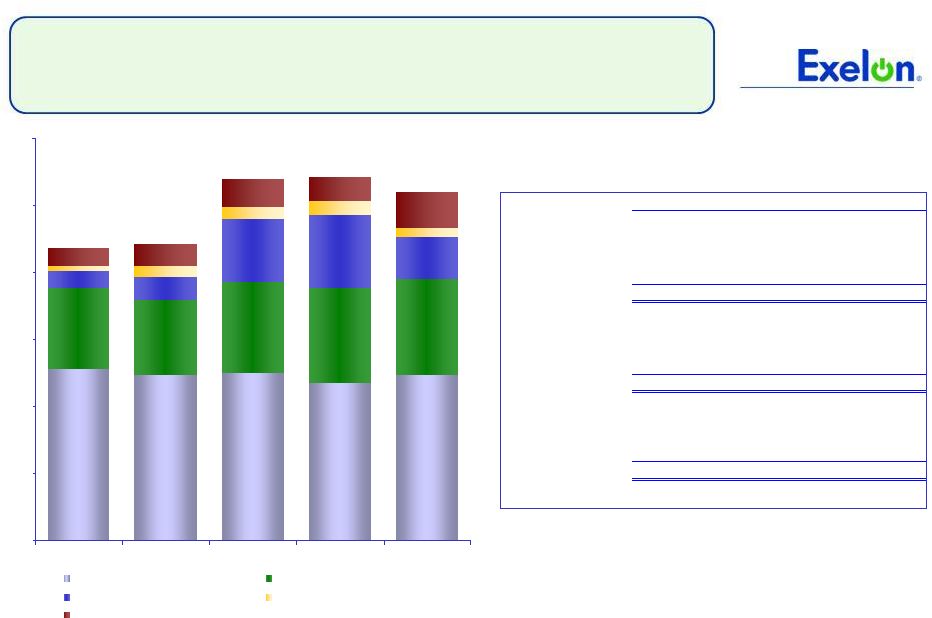 11
1,925
1,850
1,875
1,775
1,850
900
850
1,025
1,050
1,075
250
200
700
825
475
125
50
125
150
100
200
400
275
325
250
$0
$750
$1,500
$2,250
$3,000
$3,750
$4,500
2009
2010
2011E
2012E
2013E
Base CapEx
Nuclear Fuel
Nuclear Uprates and Solar/Wind
Smart Grid
New Business at Utilities
Capital Expenditures Expectations
$ millions
Exelon
$3,275
$3,325
$4,050
$4,075
$3,900
Note: Data contained on this slide is rounded.
2009
2010
2011E
2012E
2013E
Exelon Generation
Base CapEx
875
775
850
800
775
Nuclear Fuel
(1)
900
850
1,025
1,050
1,075
Nuclear Uprates
(2)
150
250
475
550
475
Solar / Wind
(3)
50
-
225
275
-
Total ExGen
1,975
1,875
2,575
2,675
2,325
ComEd
Base CapEx
650
650
700
625
675
Smart Grid/Meter
(4)
50
100
50
100
50
New Business
(5)
150
200
275
225
325
Total ComEd
850
950
1,025
950
1,050
PECO
Base CapEx
350
475
325
325
375
Smart Grid/Meter
-
25
75
50
50
New Business
50
50
50
50
75
Total PECO
400
550
450
425
500
Corporate
(6)
50
(50)
25
25
(1)
Nuclear fuel shown at ownership, including Salem.
(2)
Excludes TMI and Clinton EPUs, which are under review.
(3)
Does not include $900 million related to acquisition of John Deere Renewables.
(4)
ComEd does not plan to move forward with these Smart Grid/Meter investments unless appropriate cost
recovery mechanisms are in place. (5)
Includes transmission growth projects.
(6)
Represents capital projects transferred from Business Services Company (BSC) to Exelon Generation,
ComEd and PECO. These projects are shown as capital expenditures at Generation, ComEd and PECO
and the capital expenditure is eliminated upon consolidation - |
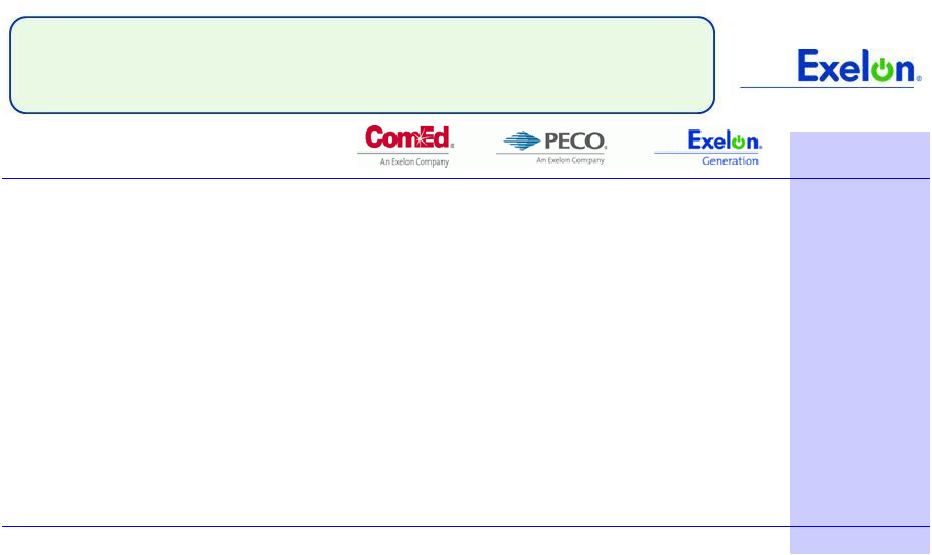 12
2011 Projected Sources and Uses of Cash
(1)
Excludes counterparty collateral activity.
(2)
Cash Flow from Operations primarily includes net cash flows provided by operating
activities and net cash flows used in investing activities other than capital expenditures.
(3)
Assumes 2011 dividend of $2.10/share. Dividends are subject to declaration by
the Board of Directors. (4)
Includes $475
million
in
Nuclear
Uprates
and
$225
million
for
Exelon Wind.
(5)
Represents new business, smart grid/smart meter investment and transmission growth
projects. (6)
Excludes ComEd’s $191 million of tax-exempt bonds that are backed by
letters of credit (LOCs). Excludes PECO’s $225 million Accounts Receivable (A/R) Agreement with Bank of Tokyo.
PECO’s A/R Agreement was extended in accordance with its terms through
September 6, 2011. (7)
“Other”
includes proceeds from options and expected changes in short-term debt.
(8) Includes cash flow activity from Holding Company, eliminations, and
other corporate entities. ($ millions)
Exelon
(8)
Beginning Cash Balance
(1)
$800
Cash Flow from Operations
(2)
425
775
3,150
4,325
CapEx (excluding Nuclear Fuel, Nuclear
Uprates, Exelon Wind, Utility Growth CapEx)
(700)
(325)
(850)
(1,875)
Nuclear Fuel
n/a
n/a
(1,025)
(1,025)
Dividend
(3)
(1,400)
Nuclear Uprates and Exelon Wind
(4)
n/a
n/a
(700)
(700)
Utility Growth CapEx
(5)
(325)
(125)
n/a
(450)
Net Financing (excluding Dividend):
Planned Debt Issuances
(6)
1,000
--
--
1,000
Planned Debt Retirements
(350)
(250)
--
(600)
Other
(7)
250
--
--
300
Ending Cash Balance
(1)
$375 |
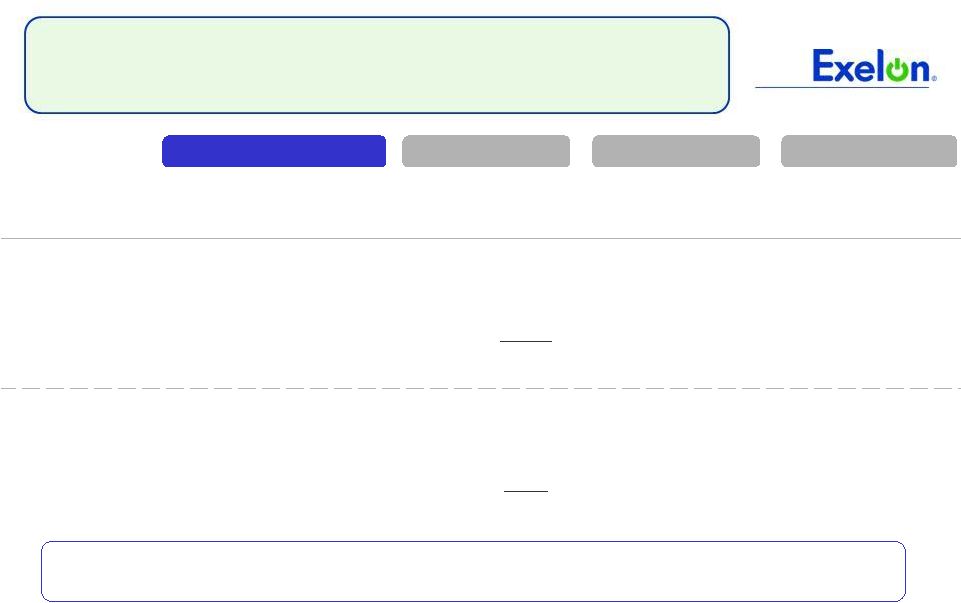 13
Pension and OPEB Expense and
Contributions –
As of 12/31/10
($ in millions)
Asset Returns
(actual for 2010 and
expected for
2011 and 2012)
Discount Rate
(used for
expense)
Pre-tax
expense
Actual
contribution
Pre-tax
expense
Expected
contribution
Pre-tax
expense
Expected
contribution
Pension
Assets
Obligations
Unfunded balance –
end of year
11.9% in 2010
8.0% in 2011
7.5% in 2012
5.83% in 2010
5.26% in 2011
5.48% in 2012
$240
$765
$8,860
$12,525
$3,665
$200
$2,100
(1)
$1,305
$240
$110
$1,015
OPEB
Assets
Obligations
Unfunded balance –
end of year
11.6% in 2010
7.08% in 2011
7.08% in 2012
5.83% in 2010
5.30% in 2011
5.52% in 2012
$190
$205
$1,655
$3,875
$2,220
$210
$185
$2,180
$225
$210
$2,140
Assumptions
2011
2012
2010
The decrease in pension expense in 2011 is primarily due to the $2.1 billion pension
contribution,
partially
offset
by
the
effects
of
lower
discount
rates
and
a
decrease
in
EROA
(1)
Exelon made a $2.1B pension contribution on January 31, 2011
(2) Pension expense amounts exclude settlement charges.
(3)
Management considers various factors when making pension funding decisions, including actuarially
determined minimum contribution requirements under ERISA, contributions required to avoid
benefit restrictions and at-risk status as defined by the Pension Protection Act of 2006 (the Act), management of the pension obligation and regulatory
implications. The Act requires the attainment of certain funding levels to avoid benefit restrictions
(such as an inability to pay lump sums or to accrue benefits prospectively), and at-risk
status (which triggers higher minimum contribution requirements and participant notification).
Note: Slide provided for illustrative purposes and not intended to represent a forecast of future
outcomes. Assumes an ~25% capitalization of pension and OPEB costs.
EROA = earned return on assets
|
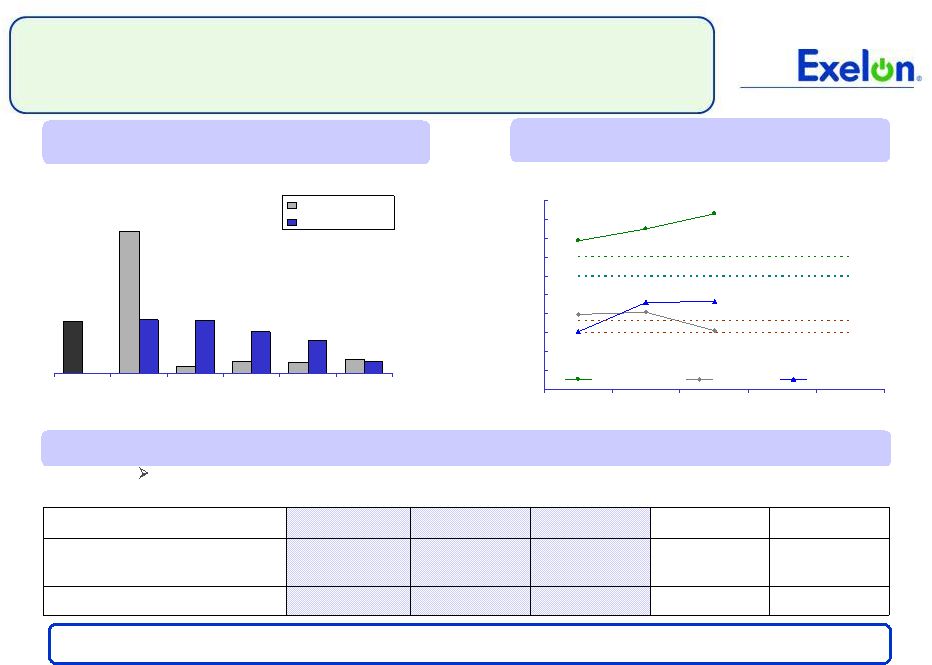 14
Driving Financial Discipline
Currently refinancing ExGen, PECO and Corp facilities; expect to close by Q1
2011 •
Three facilities totaling $6.4B will have 5-year tenor (maturing in March
2016) ($ millions)
Generation
PECO
Corporate
ComEd
Total
New Unsecured Revolving
Credit Facilities
(4)
$5,300
$600
$500
$1,000
$7,400
Expiration date
March 2016
March 2016
March 2016
March 2013
Maintaining a strong balance sheet and liquidity position
$2.1B Pension Contribution in 2011
Credit Facilities
Continued Strong Balance Sheet
FFO / Debt
(1)(2)
Pension Contributions
615
2,100
765
110
175
160
195
780
790
170
485
2010
2011
2012
2013
2014
2015
With $2.1B
Original Plan*
($ millions)
* Original
Plan
reflects
preliminary
2010
underlying
assumptions
(including
discount rate and asset returns).
0%
5%
10%
15%
20%
25%
30%
35%
40%
45%
50%
2009A
2010A
2011E
2012E
2013E
ExGen/Corp
ComEd
PECO
(3)
S&P Target Range
S&P Target Range
(1)
Reflects FFO / Debt as calculated by S&P.
(2)
Dashed lines represent S&P Target Ranges (30-35% for ExGen/Corp and 15-18% for ComEd and
PECO). See slide 15 for reconciliations to GAAP.
(3)
FFO/Debt Target Range reflects ExGen FFO/Debt in addition to the debt obligations of Exelon
Corp.
(4)
Excludes $94 million of credit facility agreements arranged with minority and community banks on
10/22/10 that are utilized solely to issue letters of credit. |
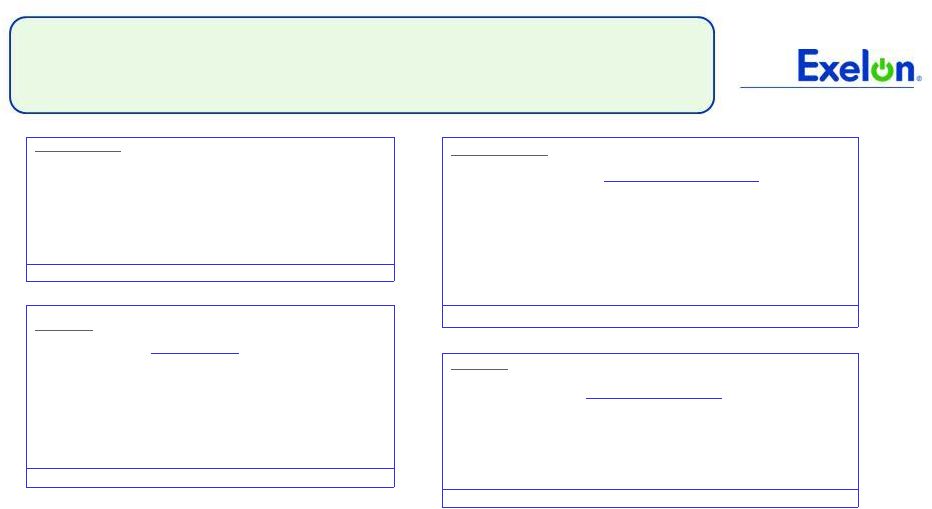 15
Metric Calculations and Ratios
FFO Calculation:
Net Cash Flows provided by Operating Activities
+/-
Change in Working Capital
+
Other
Non-Cash
items
(1)
-
AFUDC/Cap. Interest
-
Decommissioning activity
-
PECO Transition Bond Principal Paydown
= FFO
Interest Coverage:
FFO + Adjusted Interest
Adjusted Interest
Adjusted Interest:
Net Interest Expense
-
PECO Transition Bond Interest Expense
+ AFUDC & Capitalized interest
+ Interest on Present Value (PV) of Operating Leases
+ Interest on Imputed Debt Related to PV of Power Purchase Agreements (PPA)
= Adjusted Interest
FFO / Debt:
FFO
Adjusted Debt
(2)
Adjusted Debt:
LTD
+ STD
-
PECO Transition Bond Principal Balance
+
Off-balance
sheet
debt
equivalents
(3)
= Adjusted Debt
Debt / Cap:
Adjusted Debt
(2)
Adjusted Capitalization
Adjusted Capitalization:
Total shareholder’s equity
+ Preferred Securities of Subsidiaries
+ Adjusted Debt
(3)
= Adjusted Capitalization
(1)
Reflects depreciation adjustment for PPAs and operating leases and pension/OPEB contribution
normalization. (2)
Uses current year-end adjusted debt balance.
(3)
Metrics are calculated in presentation adjusted for debt equivalents for Present Value of Operating
Leases, PPAs, unfunded Pension and OPEB obligations (after-tax) and other
minor debt equivalents. |
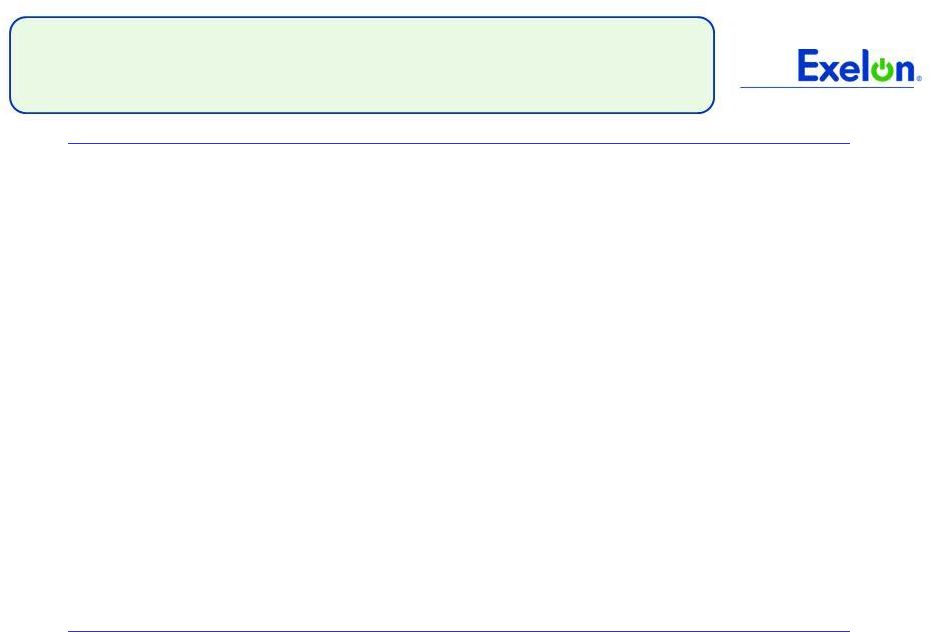 16
Key Assumptions
2009 Actual
2010 Actual
2011 Est.
(3)
Nuclear Capacity Factor (%)
(1)
93.6
93.9
93.0
Total Generation Sales Excluding Trading (GWh)
173,065
171,789
168,700
Henry Hub Gas Price ($/mmBtu)
3.92
4.37
4.56
PJM West Hub ATC Price ($/MWh)
38.30
45.93
45.45
Tetco M3 Gas Price ($/mmBtu)
4.64
5.10
5.32
PJM West Hub Implied ATC Heat Rate (mmbtu/MWh)
8.25
9.01
8.54
NI Hub ATC Price ($/MWh)
28.85
33.09
30.69
Chicago City Gate Gas Price ($/mmBtu)
3.92
4.46
4.61
NI Hub Implied ATC Heat Rate (mmbtu/MWh)
7.36
7.42
6.66
MAAC Capacity Price ($/MW-day)
158.48
181.34
136.59
EMAAC Capacity Price ($/MW-day)
173.73
181.34
136.59
RTO Capacity Price ($/MW-day)
106.13
144.40
136.59
Electric Delivery Growth (%)
(2)
PECO
0.6
0.1
0.0
ComEd
(0.1)
0.2
0.0
Effective Tax Rate -
Operating (%)
37.2
36.7
38.1
Exelon Generation
38.3
37.5
37.1
ComEd
37.9
39.7
40.8
PECO
29.5
31.1
38.0
(1)
Excludes Salem.
(2)
Weather-normalized retail load growth.
(3)
Reflects forward market prices as of December 31, 2010; Reflects assumptions used in original 2010
earnings guidance provided on
January 26, 2011.
Note: The estimates of planned generation do not represent guidance or a forecast of future
results as Exelon has not completed its planning or optimization processes.
|
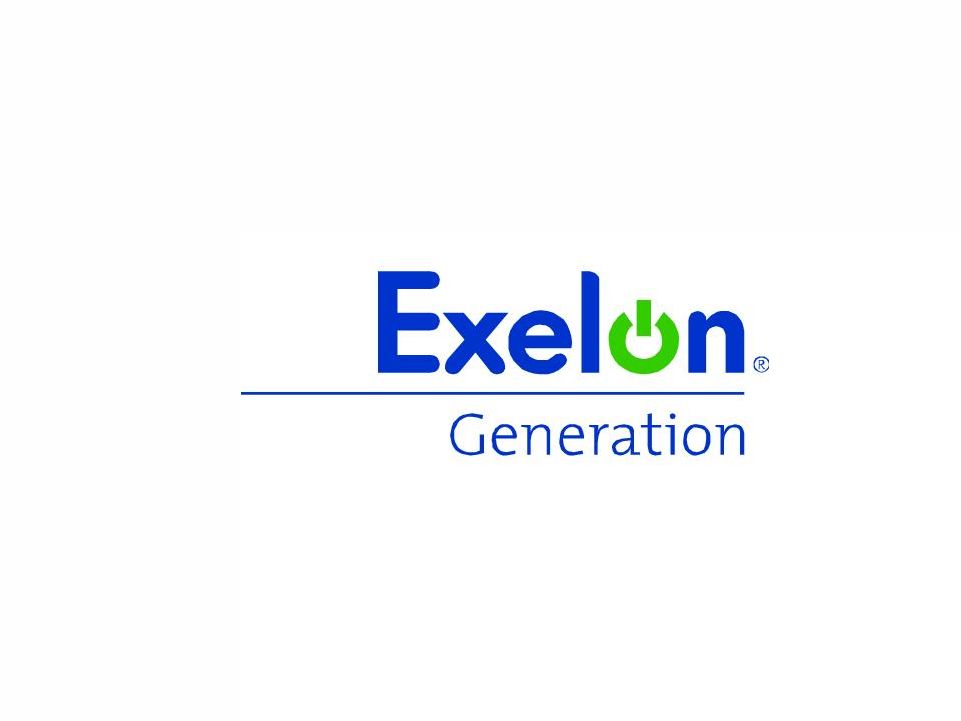  17 |
 18
Factors Influencing PJM RPM Capacity Auction
(Comparison of PY 14/15 and PY 13/14 Price Drivers)
Exelon
Price Impact
Cost of Environmental Upgrades
(1)
Higher Net CONE
(2)
Higher Net ACRs for Coal Units
(3)
Import Transmission Limits and Objectives
(muted impact on portfolio revenues due to regional diversification)
NJ CCGT Proposal / PJM Minimum Offer Price Rules
Peak Load
(4)
Demand Response Growth
2014/15 PJM Capacity Auction: Expected
Changes Since Planning Year 2013/14
(1) We expect generators to reflect cost of capital expenditures into their
cost based offers at the upcoming auction. (2) Cost of new entry
(CONE) increased by 7.6% (for RTO) and 5.3% to 6.5% (within Locational Deliverability Areas (LDAs)).
(3) Replacing 2007 net revenues with significantly lower 2010 revenues in the
Net ACR (avoidable cost rate) calculations for coal generators may increase offer caps for certain
coal
generators
in
the
next
auction.
However,
some
coal
units
may
not
be
affected
due
to
high
net
revenues
compared
to
avoidable
costs.
(4) Peak load reduced by approx. 1% in RTO (excluding the impact from Duke
Ohio integration). Note:
RPM
=
Reliability
Pricing
Model;
CCGT
=
combined
cycle
gas
turbine
Exelon’s capacity position, split almost evenly between the west and the east,
dampens the volatility to portfolio revenues from changes to transmission
limits while retaining upside across the fleet from upcoming EPA
regulations |
 19
19
Moving Generation to Market
110,594
142,400
42,003
5,295
13,897
26,300
0
50,000
100,000
150,000
200,000
2010
2011E
ComEd Swap
IL Auction
PECO Load
Actual Forward Hedges & Open Position
171,789
168,700
(1) Represents values as of December 31, 2010.
Transition to market at PECO provides additional channels to market for
Exelon Generation, including opportunities at Exelon Energy
Exelon Energy Electric Volumes
-
5
10
15
20
25
30
2008
2009
2010
2011E
2012E
2013E
MWh - Millions
COMED / Ameren
PECO/PPL
Other
Expected
Total
Sales
(GWh)
(1)
2011-2013 Sales as % of
Expected Generation
(1)
Exelon
Energy
6%
Standard
Product Sales
29%
Open
Generation
36%
Options
5%
Utility
Procurements
24% |
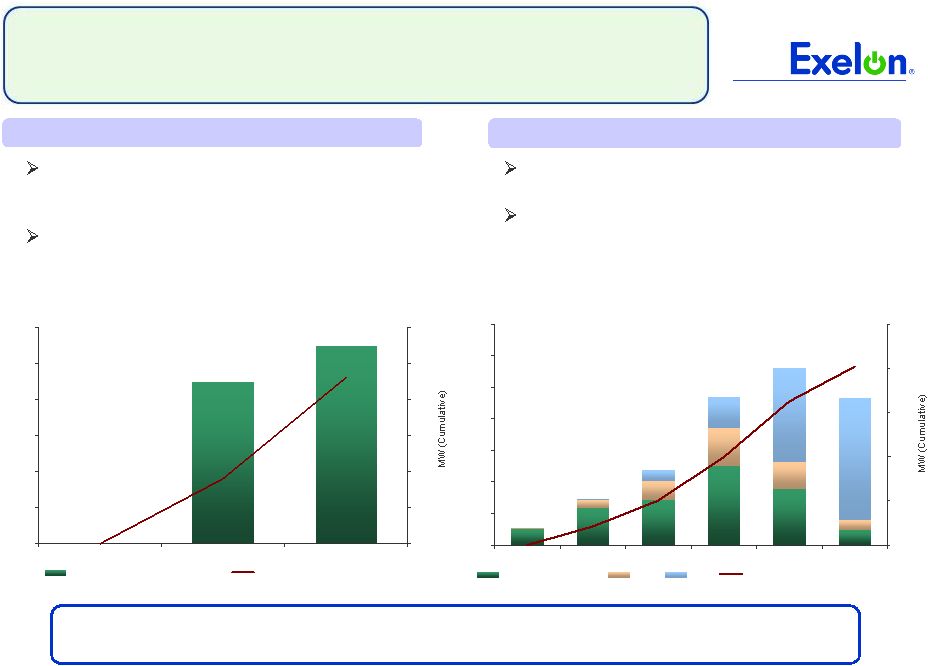  Exelon's Uprate Plan
Expenditures (1)
$0
$100
$200
$300
$400
$500
$600
$700
2008A
2009A
2010A
2011E
2012E
2013E
0
100
200
300
400
500
Megawatt Recovery
MUR
EPU
MW Online (Cumulative)
20
Exelon Wind Expenditures
(Advanced Development Projects)
$0
$50
$100
$150
$200
$250
$300
2010A
2011E
2012E
0
50
100
150
200
250
300
Annual Project CapEx
MW Online (Cumulative)
(1) Dollars shown are nominal, reflecting 6% escalation, in millions and
exclude TMI and Clinton extended power uprates, which are currently under review. MW shown at ownership.
Note: PPA = power purchase agreement; MUR = measurement uncertainty recapture; EPU
= extended power uprate. Data contained in this slide is rounded.
$150
$250
$550
$475
$475
$ millions
$50
Exelon is positioned as a key player in the US wind market and has the
largest size and scale for nuclear uprates
$ millions
Wind Development Projects
Nuclear Uprates Program
Highest return projects are being completed in
early years
Leverages Exelon’s substantial experience
managing
successful
uprate
projects
–
1,100
MW completed from 1999 to 2008, 101
MWs added in 2009-2010
Attractive economics for both operating and
advanced
development
projects
–
PPAs
already executed
Provides diversity in geographic presence
and generation type
$225
$275
Growing Our Clean Generation |
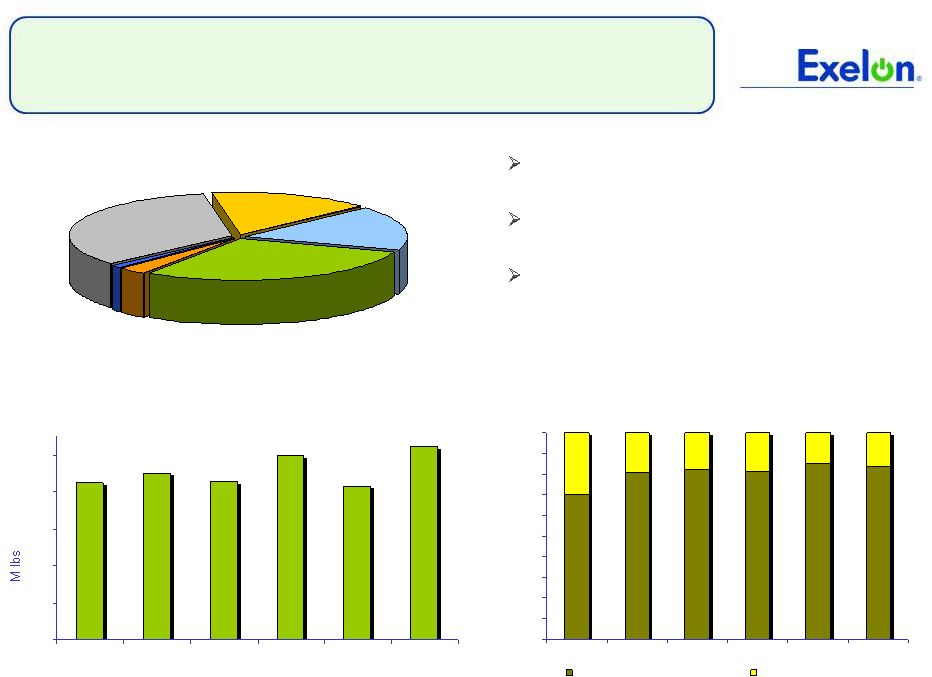 21
Effectively Managing Nuclear Fuel Costs
Uranium
29%
Conversion
3%
Tax/Interest
1%
Nuclear Waste
Fund
17%
Fabrication
16%
Enrichment
34%
Components of Fuel Expense in 2010
Projected Exelon Average Uranium Cost vs. Market
Projected Exelon Uranium Demand
2010 –
2015:
100% hedged in volume
0.0
2.0
4.0
6.0
8.0
10.0
2010
2011
2012
2013
2014
2015
Exelon Nuclear’s uranium demand is 100%
physically hedged for 2010-2015
Contracted prices continue to be below market
prices
Uranium prices were volatile over last 5 years,
but have stabilized in the $40-$60/lb range
All charts exclude Salem.
0%
10%
20%
30%
40%
50%
60%
70%
80%
90%
100%
2010
2011
2012
2013
2014
2015
Exelon Average Reload Price
Projected Market Price |
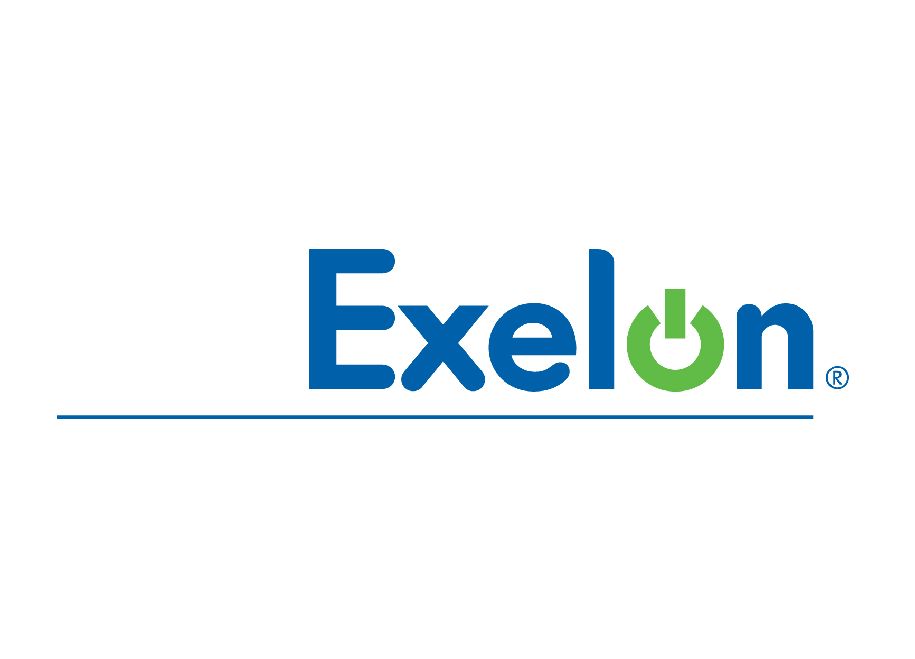 22
Environmental |
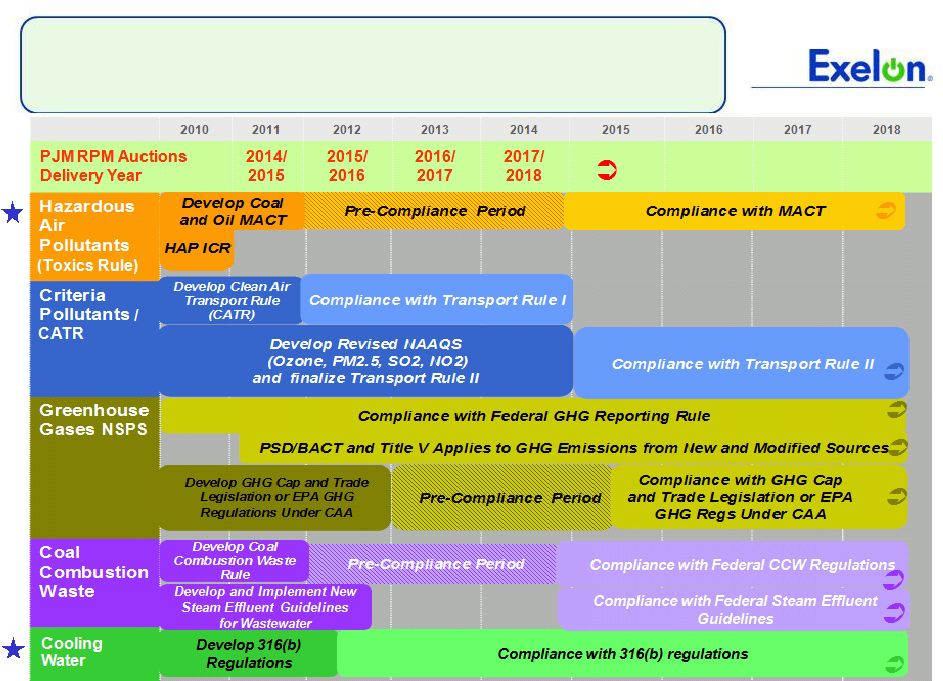 23
EPA Regulations Will Move Forward in 2011
Note: RPM auctions take place annually in May.
For
definition
of
the
EPA
regulations
referred
to
on
this
slide,
please
see
the
EPA’s
Terms
of
Environment
(http://www.epa.gov/OCEPAterms/). |
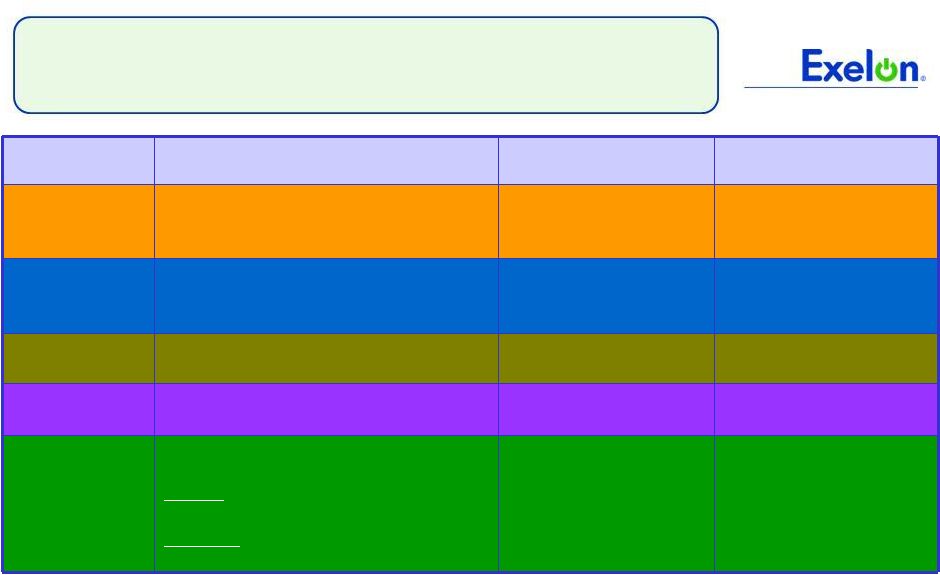 24
24
Exelon’s Exposure to EPA Regulations
EPA Regulation
Units Affected
Exelon Investment
Needed
(1)
Industry Impact
(2)
Hazardous Air
Pollutants
(Toxics Rule)
Keystone & Conemaugh
(3)
Oil-Fired Units >25 MW: ~935 MW
~$10 million
Impact to be determined
Significant, primarily fossil
fuel-fired generation
Criteria
Pollutants /
CATR
Keystone & Conemaugh
(3)
Fossil-fuel fired units >25 MW: ~4,000 MW
(4)
~$125 million
None anticipated
Compliance costs of up to
$2.8 billion / year
GHG NSPS
Fossil-fuel fired generation
(5)
Minimal due to low carbon
position of fossil fleet
Significant, primarily fossil
fuel-fired generation
Coal combustion
waste
Keystone & Conemaugh
(3)
Subtitle C: < $100 million
(6)
Subtitle D: no impact
Compliance costs up to $20
billion
Cooling Water
Facilities without closed-cycle recirculating
systems (e.g. cooling towers)
POWER: Schuylkill, Eddystone
3 & 4,
Fairless Hills, Mountain Creek, Handley
NUCLEAR: Clinton, Dresden, Quad Cities,
Peach
Bottom,
and
Salem
(7)
Impact to be determined
once rule is promulgated;
Cost to retrofit Salem
estimated at $500 million
(3)
Significant, impacts all fuel
types including large base
load and intermediate units
(1)
These rules are in the proposed or pre-proposed stage and estimates are based on published cost
studies used as inputs to IPM modeling. (2)
EPA’s estimated costs, where applicable.
(3)
Investment needed shown is Exelon’s share of the cost. Exelon owns 21% share in Keystone
and Conemaugh and 42.59% share in Salem. Keystone & Conemaugh units all have
scrubbers and Keystone units have SCRs. Salem investment estimates based on 2006 studies.
(4)
Exelon’s existing coal-fired units will be retired before this rule will take effect.
(5)
This rule applies to new sources or major modifications of existing sources and will establish
guidelines for States to incorporate into SIPS for existing sources.
(6)
Excludes Eddystone 1 and 2 and Cromby, which are scheduled to retire in 2011 and 2012.
(7)
Excludes Oyster Creek due to settlement with NJ DEP that does not require closed cycle cooling.
For definition of the EPA regulations referred to on this slide,
please see the EPA’s Terms of Environment (http://www.epa.gov/OCEPAterms/). |
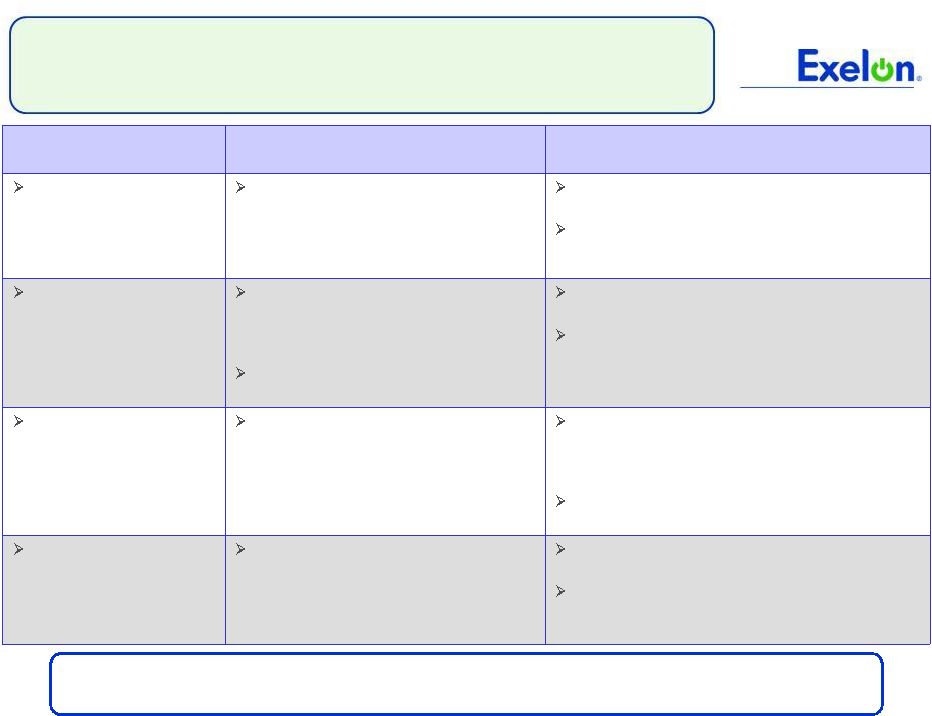 25
Why EPA Regulations Will Not Be Delayed
Opposition will have a voice, but the framework and timetable have been set
Opposing Argument
Reality
Supporting Facts
Courts will suspend the
rules or the President will
intervene
Federal court would have to determine
that the rules are inconsistent with
applicable law, which is unlikely to
occur because the amended rules are
aligned with the court’s expectations
Up to 1 year extension by EPA only if necessary
for installation of controls
President has only used exemption two times in
history (only for national security interests)
Costs are prohibitive for
industry and consumer
Proven technologies are commercially
available and have already been
installed demonstrating that the costs
can be managed
Total savings to consumer, including
healthcare impacts
Well over half of existing units have already
installed pollution controls
EPA estimates in 2014 that the proposed
Transport Rule will have annual net benefits (in
2006$) of $120-290 billion using a 3% discount
rate
Timeline is too tight for
compliance
Recent industry trends suggest that it
is reasonable to install this quantity of
scrubbers according to the proposed
timeframe.
EPA's modeling indicates that only 14 GW of
additional capacity would need to be retrofitted
with flue gas desulfurization (FGD) for Phase 2
of the Transport rule (2014)
Industry has already demonstrated ability to
schedule and sequence outages to comply
Retirements will cause
reliability issues on the
grid
Electric system reliability will not be
compromised if the industry and its
regulators manage the transition
Each NERC region has excess capacity,
totaling over 100 GW nationwide
Between 2001-2003, industry built over 160 GW
of
new
generation
–
four
times
what
is
projected
will retire over next 5 years |
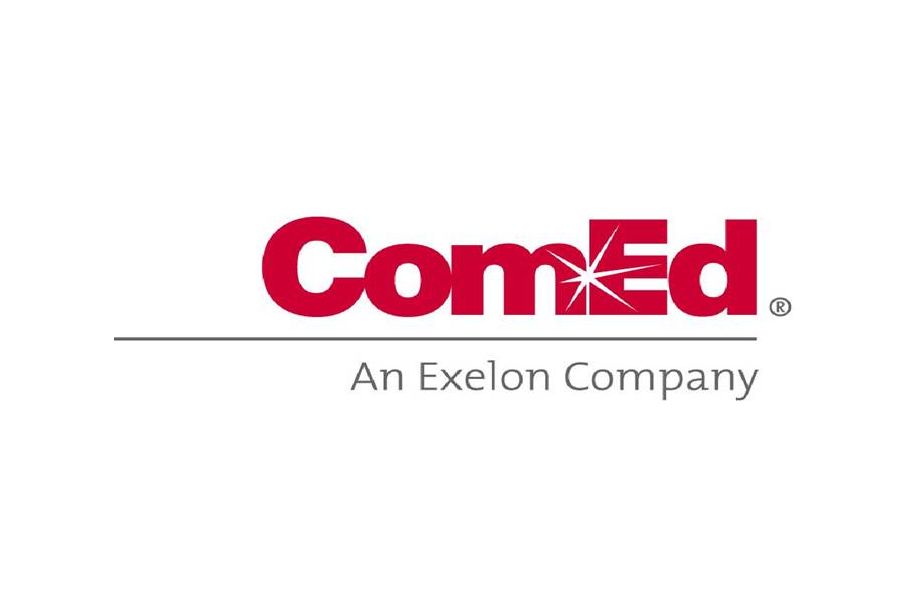 26 |
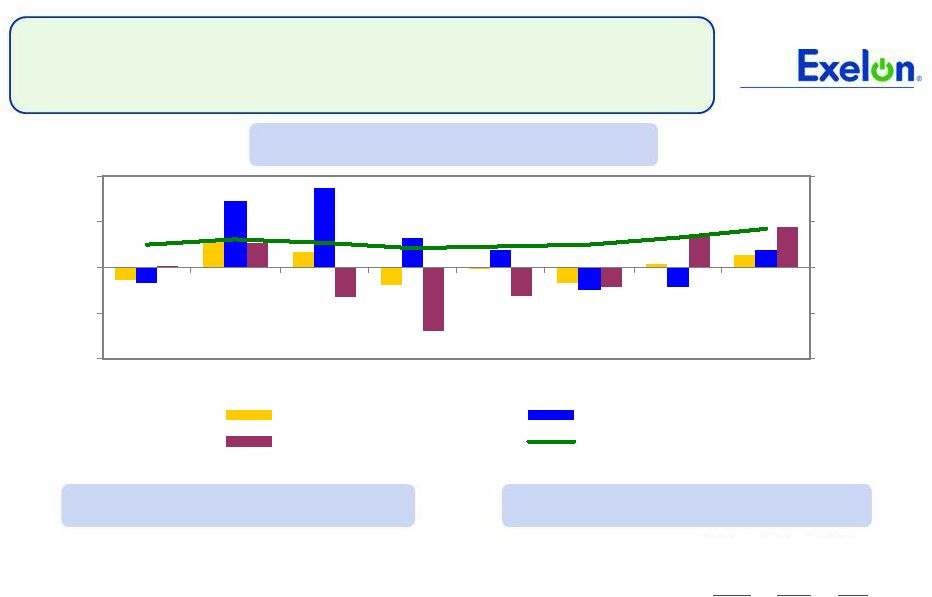 27
27
ComEd Load Trends
Note: C&I = Commercial & Industrial
Weather-Normalized Load Year-over-Year
4Q10
2010 2011E
Average Customer Growth
0.4%
0.2%
0.5%
Average Use-Per-Customer
(4.5)%
(1.4)%
0.0%
Total Residential
(4.1)%
(1.2)% 0.5%
Small C&I
(1.5)%
(0.6)% (0.3)%
Large C&I
1.9%
2.6% (0.2)%
All Customer Classes
(1.2)%
0.2% 0.0%
(1)
Source: U.S. Dept. of Labor (December 2010) and Illinois
Department of Security (December 2010)
(2) Source: Global Insight December 2010
-6.0%
-3.0%
0.0%
3.0%
6.0%
1Q10
2Q10
3Q10
4Q10
1Q11
2Q11
3Q11
4Q11
-6.0%
-3.0%
0.0%
3.0%
6.0%
All Customer Classes
Large C&I
Residential
Gross Metro Product
Key Economic Indicators
Weather-Normalized Load
Chicago
U.S.
Unemployment rate
(1)
9.3%
9.4%
2010 annualized growth in
gross domestic/metro product
(2)
1.6%
2.8% |
 28
28
28
ComEd 2010 Rate Case Update
ComEd Reply Brief (2/23/11)
$343M increase requested
11.50% ROE / 47.28% equity ratio
Rate base $7,349M
2009 test year with pro forma plant
additions through 6/30/11
ICC Staff Reply Brief Position
$113M increase proposed
10.00% ROE / 47.11% equity ratio
Rate base $6,480M
Pro forma plant additions and
depreciation reserve through 12/31/10
(ICC Docket No. 10-0467)
$ millions
ComEd Original Request (6/30/10)
396
$
Adjustments:
Bonus Depreciation
(14)
Pro forma plant adds/O&M update
(4)
Errata in Initial Filing
(12)
Reduction to Reg Asset Amortization
(8)
Other Items
(4)
ComEd Rebuttal (11/22/10)
354
$
Adjustments:
New Bonus Depreciation
(22)
Pro forma plant adds/O&M update
(4)
Reduction to AMI/Other
(2)
ComEd Surrebuttal (1/3/2011)
326
$
Adjustments:
IL Business Tax Increase
17
ComEd Reply Brief (2/23/11)
343
$
Reconciliation of ComEd Initial Request to Reply Brief
* ComEd request does not reflect Appellate Court decision relating to
depreciation reserve, which we estimate would have a $85M reduction
to revenue requirement
* |
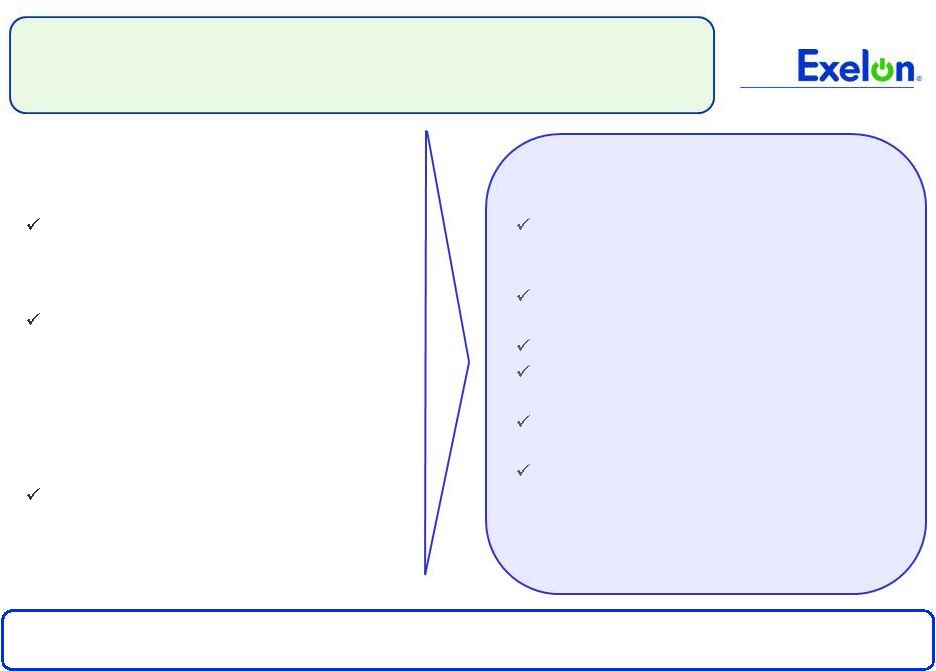 29
29
ComEd –
Proposed Infrastructure
Investment and Modernization Legislation
Proposed Grid Modernization
Legislation Key Concepts
Incremental investment of $2.6B of capital
over 10 years
•
$1.5B smart grid/smart meter
•
$1.1B infrastructure improvements
Incorporates an annual formula rate
proceeding, similar to FERC Transmission
rate
•
Protocols clarify treatment of several
significant items, including pension costs
and pension asset
•
ROE formula based on average 30-year
Treasury yield
Reduces proceeding timeframe from 11
months to less than 9 months
ComEd is driving innovative regulatory and legislative strategy to benefit customers,
improve the transparency of the ratemaking process and enable economic
development Proposed Grid Modernization
Legislation Customer Benefits
Quantifiable benefits to customers of 12
million avoided outages and hundreds of
millions in avoided costs
Put a smart meter in every home and
provide extensive consumer education
Significantly improve meter reading
Create 2,000 jobs at the peak of the
investment cycle
Create $100M in Illinois tax revenues over
the life of the program
Enhance the economic competitiveness of
Illinois; make our state better positioned to
attract businesses and jobs |
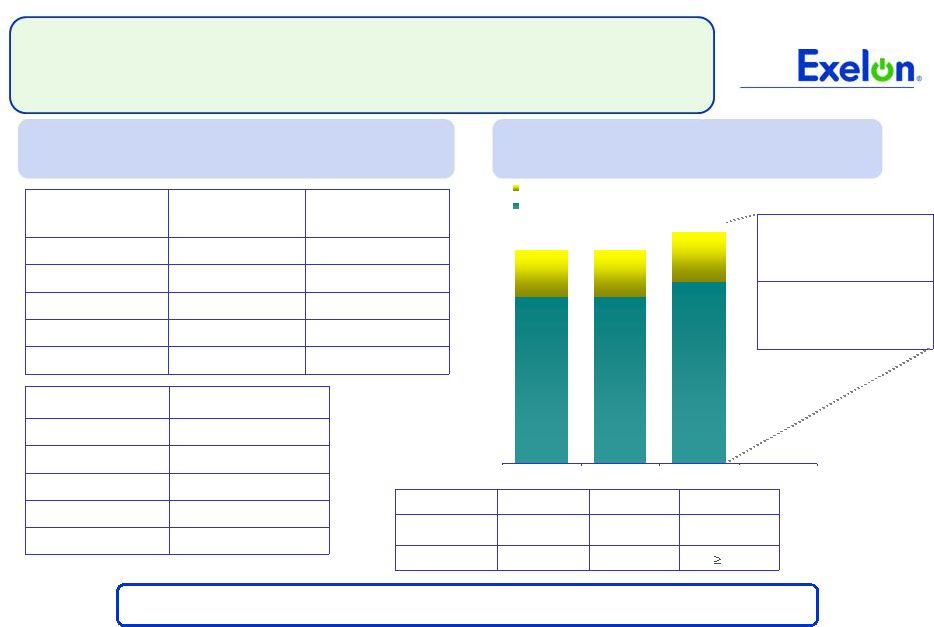 30
2009
2010
Target
Equity
~46%
~45%
~45%
Earned ROE
8.5%
10.6%
30
6.7
7.3
1.9
2.0
6.7
1.9
Transmission
Distribution
ComEd
Rate Base Growth
ELECTRIC
DISTRIBUTION
Prior Rate Case
ComEd
Surrebuttal
1/3/2011
Rates Effective
October 1, 2008
June 1, 2011
Test Year
2006 pro forma
2009 pro forma
Rate Base
$6,694 million
$7,349 million
ROE
10.3%
11.5%
Equity %
45.04%
47.28%
TRANSMISSION
FERC Formula rate
Rates Effective
June 1, 2010
Test Year
2009 pro forma
Rate Base
$1,949 million
ROE
11.5%
Equity %
56%
Transmission: FERC
formula rate adjusted
every year on June 1
Distribution rate
cases expected every
~1-2 years
$8.6
$8.6
2009
2010
2011E
$9.3
ComEd
executing on regulatory recovery plan
Rate Base in Rates
End of Year ($ in billions)
(1)
Recent Rate Cases
10%
(1)
Amounts include pro forma adjustments. On September 30, 2010, the Illinois Appellate Court ruled
with regard to ComEd’s 2007 distribution rate case and held that the ICC abused its
discretion in not reducing ComEd’s rate base to account for an additional 18 months of accumulated depreciation while including pro forma plant additions post-test
year through that period. The Court remanded the case to the ICC. For the 2007 rate case,
the Court’s ruling would reduce the $6,694 million rate base by ~$500 - $670 million
resulting in a revenue reduction between $57 and $77 million. For the current rate case,
updating the depreciation and deferred tax reserves to June 2011 would reduce the $7,349
million rate base by an estimated $667 million and would reduce the revenue requirement by approximately $85 million.
Note: Amounts may not add due to rounding.
|
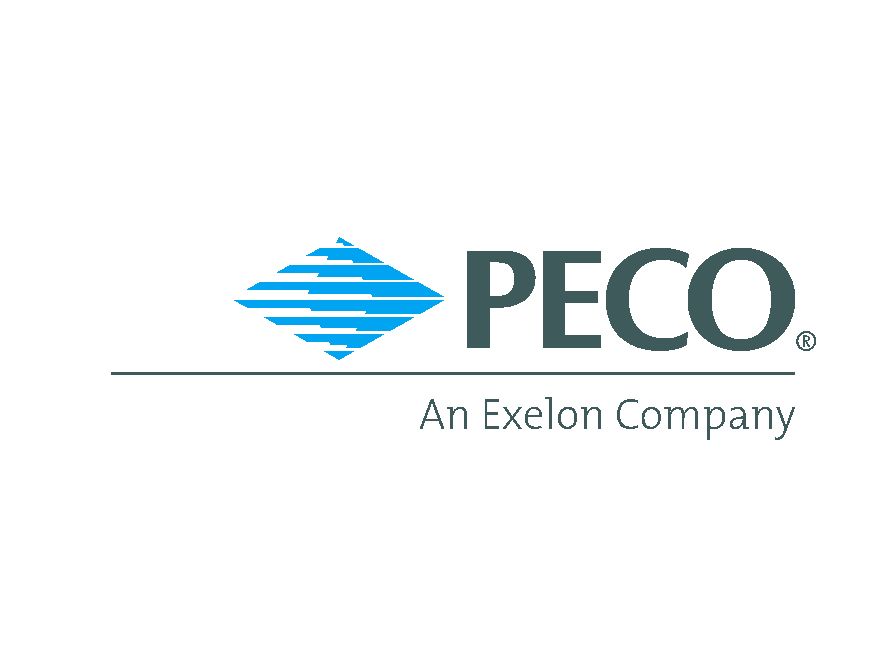 31 |
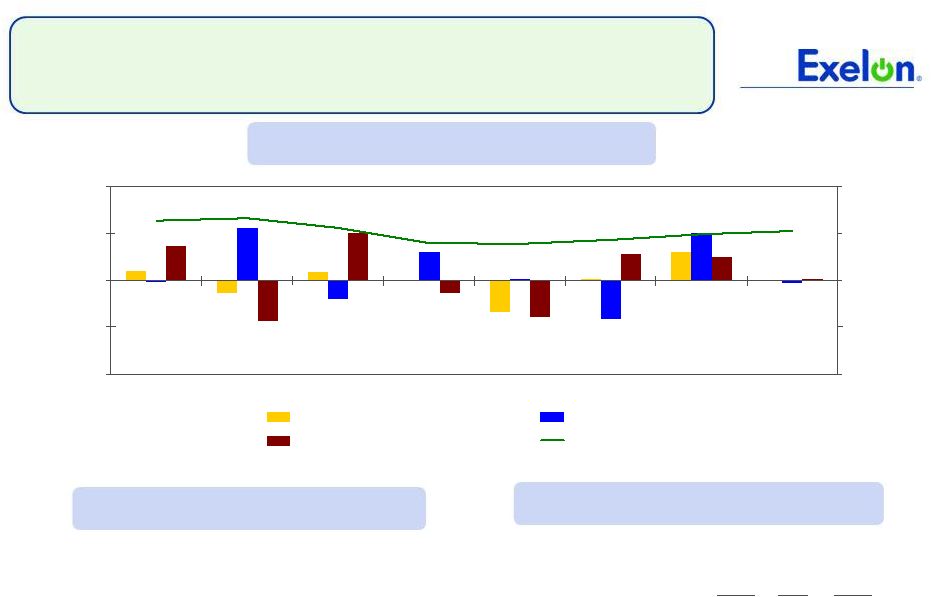 32
PECO Load Trends
Philadelphia
U.S.
Unemployment rate
(1)
8.4%
9.4% 2010 annualized growth in
gross
domestic/metro
product
(2)
2.8%
2.8% Note: C&I = Commercial & Industrial
Weather-Normalized Load Year-over-Year
Key Economic Indicators
Weather-Normalized Load
4Q10
2010 2011E
Average Customer Growth
0.5%
0.3%
0.4%
Average Use-Per-Customer
(1.2)%
0.3%
(0.3)%
Total Residential
(0.7)%
0.5% 0.1%
Small C&I
(2.0)%
(1.9)% (0.5)%
Large C&I
1.5%
0.8% 0.1%
All Customer Classes
0.0%
0.1% 0.0%
(1)
Source:
U.S
Dept.
of
Labor
(PHL
–
November
2010
preliminary data, US -
December 2010)
(2)
Source: Global Insight December 2010
-5.0%
-2.5%
0.0%
2.5%
5.0%
1Q10
2Q10
3Q10
4Q10
1Q11E
2Q11E
3Q11E
4Q11E
-5.0%
-2.5%
0.0%
2.5%
5.0%
All Customer Classes
Large C&I
Residential
Gross Metro Product |
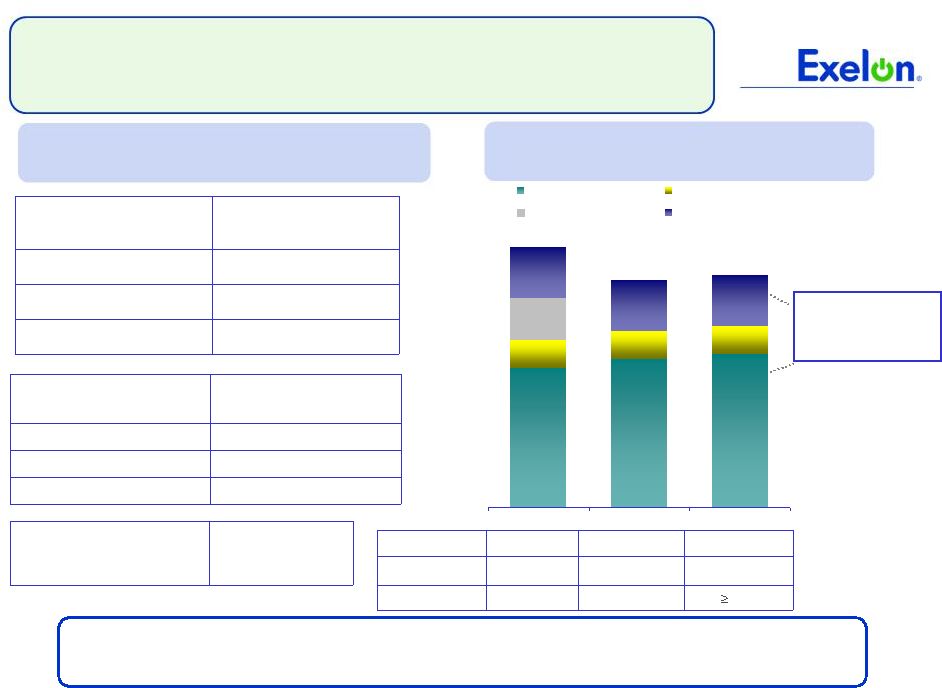 33
3.0
3.2
3.3
0.6
0.6
0.6
1.1
1.1
1.1
0.9
Electric Distribution
Electric Transmission
CTC
Gas
PECO Executing on Transition Plan
ELECTRIC
DISTRIBUTION
Filing
3/31/2010
Rates Effective
January 1, 2011
Test Year
2010
Revenue Increase
$225 million
GAS DELIVERY
Filing
3/31/2010
Rates Effective
January 1, 2011
Test Year
2010
Revenue Increase
$20 million
TRANSMISSION
Stated rate; no
recent rate cases
$5.6
$4.9
2009
2010
(1)
As determined for rate-making purposes. Amounts reflect pro forma adjustments
that may be made to determine rate base for rate case filing purposes.
(2)
Operating Net income basis
$5.0
2011E
PECO
is
managing
through
its
transition
period
and
is
positioned
for
continued strong financial performance post-2010
Rate Base in Rates
End of Year Balance ($ in billions)
(1)
Recent Rate Cases
(1)
Periodic rate
cases
going forward
2009
2010
Target
Equity
(1)
53%
53%
51-53%
Earned ROE
(2)
14.8%
12.9%
10% |
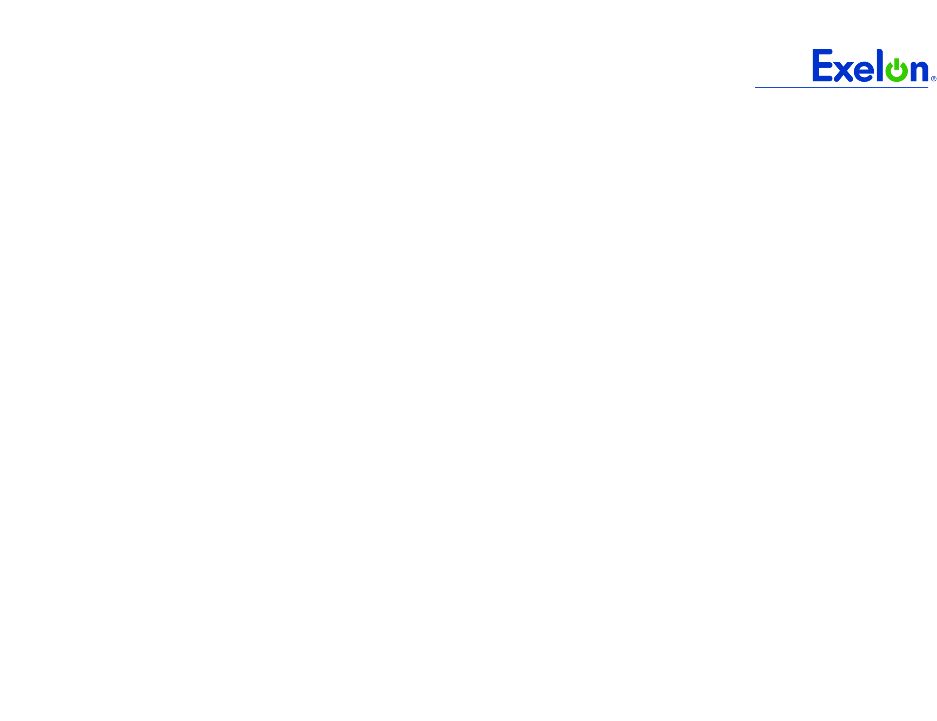  34
Exelon Generation Hedging Disclosures
(as of December 31, 2010) |
 35
35
Important Information
The following slides are intended to provide additional information regarding the hedging
program at Exelon Generation and to serve as an aid for the purposes of modeling Exelon
Generation’s gross margin (operating revenues less purchased power and fuel expense). The
information on the following slides is not intended to represent earnings guidance or a forecast
of future events. In fact, many of the factors that ultimately will determine Exelon
Generation’s actual gross margin are based upon highly variable market factors outside of
our control. The information on the following slides is as of December 31, 2010. We
update this information on a quarterly basis. Certain information on the following slides is based upon an internal simulation model that
incorporates assumptions regarding future market conditions, including power and commodity
prices, heat rates, and demand conditions, in addition to operating performance and dispatch
characteristics of our generating fleet. Our simulation model and the assumptions therein are
subject to change. For example, actual market conditions and the dispatch profile of our
generation fleet in future periods will likely differ – and may differ significantly –
from the assumptions underlying the simulation results included in the slides. In addition,
the forward- looking information included in the following slides will likely change over time
due to continued refinement of our simulation model and changes in our views on future market
conditions. |
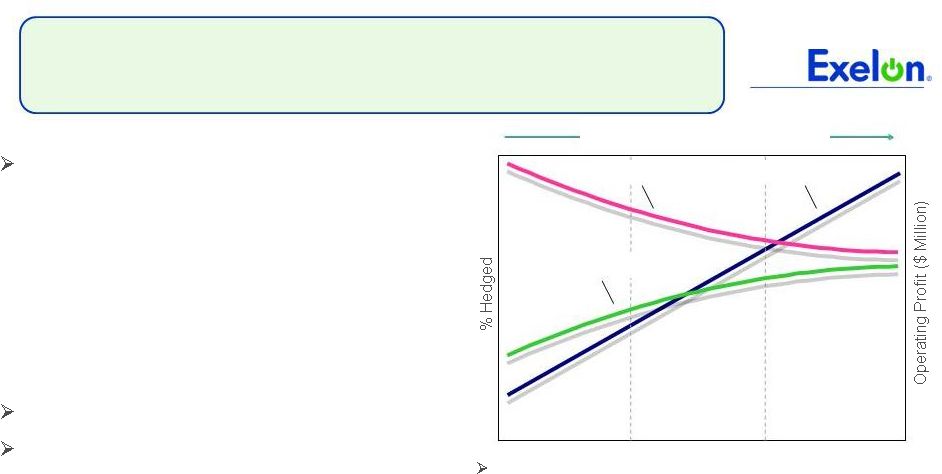 36
36
Portfolio Management Objective
Align Hedging Activities with Financial Commitments
Power Team utilizes several product types
and channels to market
•
Wholesale and retail sales
•
Block products
•
Load-following products
and load auctions
•
Put/call options
Exelon’s hedging program is designed to
protect the long-term value of our
generating fleet and maintain an
investment-grade balance sheet
•
Hedge enough commodity risk to meet future cash
requirements if prices drop
•
Consider: financing policy (credit rating objectives,
capital structure, liquidity); spending (capital and
O&M); shareholder value return policy
Consider market, credit, operational risk
Approach to managing volatility
•
Increase hedging as delivery approaches
•
Have enough supply to meet peak load
•
Purchase fossil fuels as power is sold
•
Choose hedging products based on generation
portfolio
–
sell
what
we
own
•
Heat rate options
•
Fuel products
•
Capacity
•
Renewable credits
% Hedged
High End of Profit
Low End of Profit
Open Generation
with LT Contracts
Portfolio
Optimization
Portfolio
Management
Portfolio Management Over Time |
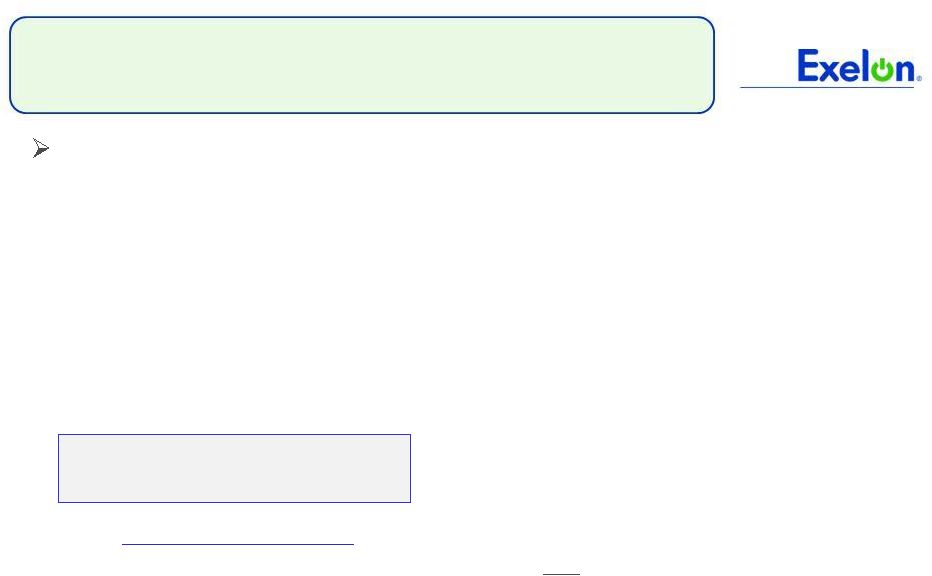 37
37
Percentage of Expected
Generation Hedged
•
How many equivalent MW have been
hedged at forward market prices; all hedge
products used are converted to an
equivalent average MW volume
•
Takes ALL
hedges into account whether
they are power sales or financial products
Equivalent MWs
Sold
Expected Generation
=
Our normal practice is to hedge commodity risk on a ratable basis
over the three years leading to the spot market
•
Carry operational length into spot market to manage forced outage and
load-following risks
•
By
using
the
appropriate
product
mix,
expected
generation
hedged
approaches
the
mid-90s percentile as the delivery period approaches
•
Participation in larger procurement events, such as utility auctions, and some
flexibility in the timing of hedging may mean the hedge program is not
strictly ratable from quarter to quarter
Exelon Generation Hedging Program |
 38
38
2011
2012
2013
Estimated Open Gross Margin ($ millions)
(1)(2)(3)
$5,200
$5,050
$5,700
Open gross margin assumes all expected generation is sold
at the Reference Prices listed below
Reference Prices
(1)
Henry Hub Natural Gas ($/MMBtu)
NI-Hub ATC Energy Price ($/MWh)
PJM-W ATC Energy Price ($/MWh)
ERCOT
North
ATC
Spark
Spread
($/MWh)
(4)
$4.56
$30.69
$45.45
$1.12
$5.08
$32.38
$46.41
$0.82
$5.33
$35.09
$48.25
$1.84
Exelon Generation Open Gross Margin and
Reference Prices
(1)
Based on December 31, 2010 market conditions.
(2)
Gross margin is defined as operating revenues less fuel expense and purchased power
expense, excluding the impact of decommissioning and other incidental revenues. Open
gross margin is estimated based upon an internal model that is developed by
dispatching our expected generation to current market power and fossil fuel prices. Open gross margin
assumes
there
is
no
hedging
in
place
other
than
fixed
assumptions
for
capacity
cleared
in
the
RPM
auctions
and
uranium
costs
for
nuclear
power
plants.
Open
gross
margin
contains assumptions for other gross margin line items such as various ISO bill and
ancillary revenues and costs and PPA capacity revenues and payments. The estimation of open
gross margin incorporates management discretion and modeling assumptions that are
subject to change. (3)
As of December 31, 2010 disclosure, Exelon Wind included. Assets in IL,
MI and MN are in Midwest region and assets in ID, KS, MO, OR and TX are in South and West region.
(4)
ERCOT North ATC spark spread using Houston Ship Channel Gas, 7,200 heat rate, $2.50
variable O&M. |
 39
39
2011
2012
2013
Expected Generation
(GWh)
(1)
165,900
165,800
163,300
Midwest
99,600
98,500
96,200
Mid-Atlantic
56,800
57,200
56,500
South & West
9,500
10,100
10,600
Percentage
of
Expected
Generation
Hedged
(2)
90-93%
67-70%
32-35%
Midwest
91-94
69-72
31-34
Mid-Atlantic
93-96
67-70
36-39
South & West
70-73
51-54
39-42
Effective
Realized
Energy
Price
($/MWh)
(3)
Midwest
$43.00
$41.50
$43.50
Mid-Atlantic
$57.00
$50.50
$51.50
South & West
$2.50
$(1.00)
$(3.50)
Generation Profile
(1)
Expected generation represents the amount of energy estimated to be generated or purchased through
owned or contracted for capacity. Expected generation is based upon a simulated dispatch
model that makes assumptions regarding future market conditions, which are calibrated to market quotes for power, fuel, load following products, and options.
Expected generation assumes 12 refueling outages in 2011 and 10 refueling outages in 2012 and 2013 at
Exelon-operated nuclear plants and Salem. Expected generation assumes capacity
factors of 93.0%, 93.6% and 93.1% in 2011, 2012 and 2013 at Exelon-operated nuclear plants. These estimates of expected generation in 2012 and 2013 do
not represent guidance or a forecast of future results as Exelon has not completed its planning or
optimization processes for those years. (2)
Percent of expected generation hedged is the amount of equivalent sales divided by the expected
generation. Includes all hedging products, such as wholesale and retail sales of power,
options, and swaps. Uses expected value on options. Reflects decision to permanently retire Cromby Station and Eddystone Units 1&2 as of May 31, 2011.
(3)
Effective realized energy price is representative of an all-in hedged price, on a per MWh basis,
at which expected generation has been hedged. It is developed by considering the energy
revenues and costs associated with our hedges and by considering the fossil fuel that has been purchased to lock in margin. It excludes uranium costs and RPM capacity
revenue, but includes the mark-to-market value of capacity contracted at prices other than RPM
clearing prices including our load obligations. It can be compared with the reference
prices used to calculate open gross margin in order to determine the mark-to-market value of Exelon Generation's energy hedges. |
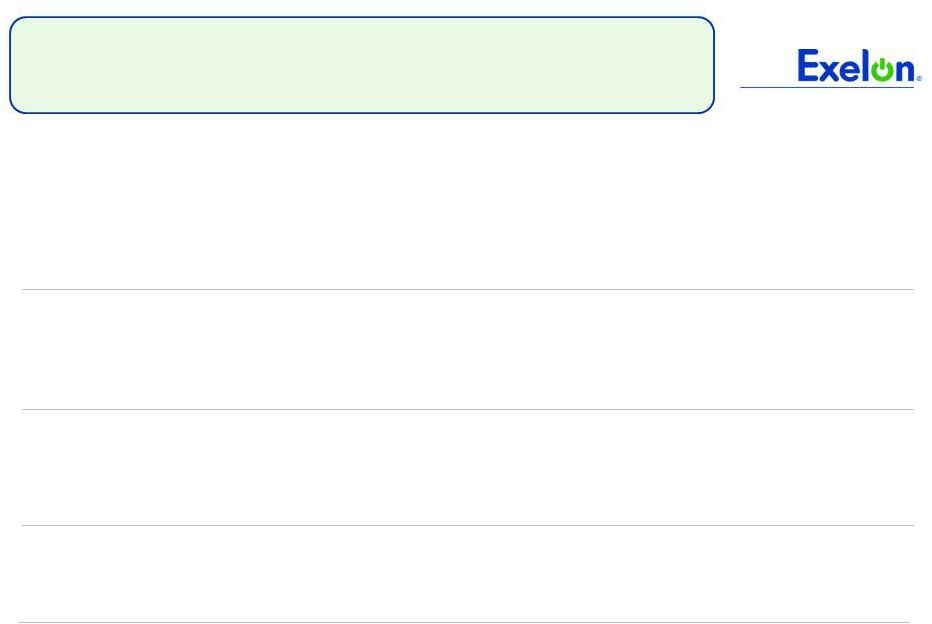 40
40
Gross Margin Sensitivities with Existing Hedges ($ millions)
(1)
Henry Hub Natural Gas
+ $1/MMBtu
-
$1/MMBtu
NI-Hub ATC Energy Price
+$5/MWH
-$5/MWH
PJM-W ATC Energy Price
+$5/MWH
-$5/MWH
Nuclear Capacity Factor
+1% / -1%
2011
$5
$(5)
$30
$(20)
$15
$(10)
+/-
$40
2012
$175
$(95)
$185
$(165)
$115
$(110)
+/-
$45
2013
$495
$(445)
$340
$(335)
$200
$(195)
+/-
$50
Exelon Generation Gross Margin Sensitivities
(with Existing Hedges)
(1)
Based on December 31, 2010 market conditions and hedged position. Gas price
sensitivities are based on an assumed gas-power relationship derived from an
internal
model
that
is
updated
periodically.
Power
prices
sensitivities
are
derived
by
adjusting
the
power
price
assumption
while
keeping
all
other
prices
inputs
constant. Due to correlation of the various assumptions, the hedged gross margin
impact calculated by aggregating individual sensitivities may not be equal to the
hedged gross margin impact calculated when correlations between the various
assumptions are also considered. |
 41
41
95% case
5% case
$5,400
$7,100
$6,800
$6,300
Exelon Generation Gross Margin Upside / Risk
(with Existing Hedges)
$3,000
$4,000
$5,000
$6,000
$7,000
$8,000
$9,000
2011
2012
$7,200
$5,000
2013
(1)
Represents an approximate range of expected gross margin, taking into account hedges in place, between
the 5th and 95th percent confidence levels assuming all unhedged supply is sold into the spot
market. Approximate gross margin ranges are based upon an internal simulation model and are subject to change based upon market inputs, future
transactions and potential modeling changes. These ranges of approximate gross margin in 2012 and 2013
do not represent earnings guidance or a forecast of future results as Exelon has not completed
its planning or optimization processes for those years. The price distributions that generate this range are calibrated to market quotes for power, fuel,
load following products, and options as of December 31, 2010. |
 42
42
Midwest
Mid-Atlantic
South & West
Step 1
Start
with
fleetwide
open
gross
margin
$5.20 billion
Step 2
Determine
the
mark-to-market
value
of
energy hedges
99,600GWh * 92% *
($43.00/MWh-$30.69MWh)
= $1.13 billion
56,800GWh * 94% *
($57.00/MWh-$45.45MWh)
= $0.62 billion
9,500GWh * 71% *
($2.50/MWh-$1.12/MWh)
= $0.01 billion
Step 3
Estimate
hedged
gross
margin
by
adding open gross margin to mark-to-
market value of energy hedges
Open gross margin:
MTM
value
of
energy
hedges:
Estimated hedged gross margin:
Illustrative Example
of Modeling Exelon Generation 2011 Gross Margin
(with Existing Hedges)
$1.13
billion
+
$0.62
billion
+
$0.01
billion
$5.20 billion
$6.96 billion |
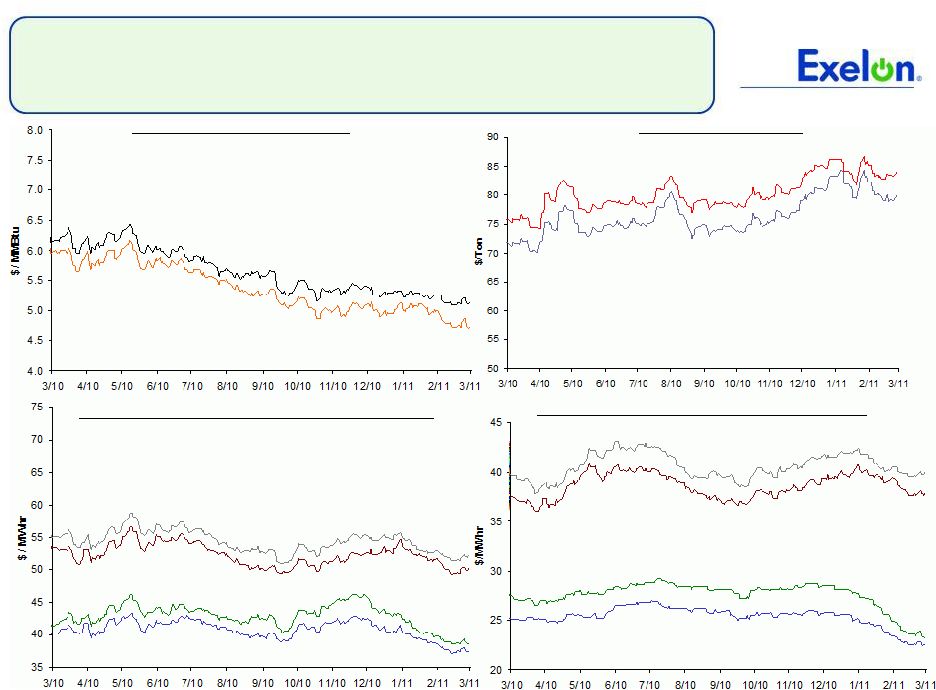 Market Price Snapshot
Forward NYMEX Natural Gas
PJM-West and Ni-Hub On-Peak Forward Prices
PJM-West and Ni-Hub Wrap Forward Prices
2012
$5.37
2013
$5.64
Rolling
12
months,
as
of
March
4
2011.
Source:
OTC
quotes
and
electronic
trading
system.
Quotes
are
daily.
Forward NYMEX Coal
2012
$76.44
2013
$80.28
2012
Ni-Hub
$40.80
2013
Ni-Hub
$42.87
2013
PJM-West
$54.34
2012
PJM-West
$52.32
2012
Ni-Hub
$25.40
2013
Ni-Hub
$27.58
2013
PJM-West
$40.56
2012
PJM-West
$38.63
43
th |
 44
4.5
5.5
6.5
7.5
8.5
9.5
10.5
11.5
12.5
13.5
3/10
4/10
5/10
6/10
7/10
8/10
9/10
10/10
11/10
12/10
1/11
2/11
3/11
8.0
8.2
8.4
8.6
8.8
9.0
9.2
9.4
9.6
9.8
10.0
3/10
4/10
5/10
6/10
7/10
8/10
9/10
10/10
11/10
12/10
1/11
2/11
3/11
35
40
45
50
55
60
65
70
3/10
4/10
5/10
6/10
7/10
8/10
9/10
10/10
11/10
12/10
1/11
2/11
3/11
3.5
4.0
4.5
5.0
5.5
6.0
6.5
7.0
7.5
8.0
3/10
4/10
5/10
6/10
7/10
8/10
9/10
10/10
11/10
12/10
1/11
2/11
3/11
Market Price Snapshot
2013
9.31
2012
9.15
2012
$48.07
2013
$51.38
2012
$5.26
2013
$5.52
Houston Ship Channel Natural Gas
Forward Prices
ERCOT North On-Peak Forward Prices
ERCOT North On-Peak v. Houston Ship Channel
Implied Heat Rate
2012
$7.64
2013
$9.05
ERCOT North On Peak Spark Spread
Assumes a 7.2 Heat Rate, $1.50 O&M, and $.15 adder
Rolling
12
months,
as
of
March
4
2011.
Source:
OTC
quotes
and
electronic
trading
system.
Quotes
are
daily.
th |
 45
4Q GAAP EPS Reconciliation
Three Months Ended December 31, 2010
ExGen
ComEd
PECO
Other
Exelon
2010 Adjusted (non-GAAP) Operating Earnings (Loss) Per Share
$0.81
$0.13
$0.03
$(0.01)
$0.96
Mark-to-market adjustments from economic hedging activities
(0.17)
-
-
-
(0.17)
2007 Illinois electric rate settlement
(0.01)
-
-
-
(0.01)
Unrealized gains related to nuclear decommissioning trust funds
0.04
-
-
-
0.04
Retirements of fossil generation units / plant retirements
(0.03)
-
-
-
(0.03)
John Deere Renewables acquisition costs
(0.01)
-
-
-
(0.01)
Asset Retirement Obligation reduction
-
0.01
-
-
0.01
4Q 2010 GAAP Earnings (Loss) Per Share
$0.63
$0.14
$0.03
$(0.01)
$0.79
NOTE: All amounts shown are per Exelon share and represent contributions to
Exelon's EPS. Amounts may not add due to rounding. Three Months Ended
December 31, 2009 ExGen
ComEd
PECO
Other
Exelon
2009 Adjusted (non-GAAP) Operating Earnings (Loss) Per Share
$0.66
$0.16
$0.12
$(0.02)
$0.92
Mark-to-market adjustments from economic hedging activities
0.04
-
-
-
0.04
2007 Illinois electric rate settlement
(0.02)
-
-
-
(0.02)
Unrealized gains related to nuclear decommissioning trust funds
0.02
-
-
-
0.02
City of Chicago settlement with ComEd
-
(0.01)
-
-
(0.01)
Costs associated with early debt retirements
(0.01)
-
-
(0.01)
(0.02)
Retirement of fossil generating units
(0.05)
-
-
-
(0.05)
4Q 2009 GAAP Earnings (Loss) Per Share
$0.64
$0.15
$0.12
$(0.03)
$0.88 |
 46
Full Year GAAP EPS Reconciliation
NOTE: All amounts shown are per Exelon share and represent contributions to
Exelon's EPS. Amounts may not add due to rounding. Twelve Months Ended
December 31, 2010 ExGen
ComEd
PECO
Other
Exelon
2010 Adjusted (non-GAAP) Operating Earnings (Loss) Per Share
$2.91
$0.68
$0.54
$(0.07)
$4.06
Mark-to-market adjustments from economic hedging activities
0.08
-
-
-
0.08
2007 Illinois electric rate settlement
(0.02)
-
-
-
(0.02)
Unrealized gains related to nuclear decommissioning trust funds
0.08
-
-
-
0.08
Asset Retirement Obligation reduction
-
0.01
-
-
0.01
Retirement of fossil generating units
(0.08)
-
-
-
(0.08)
Non-cash remeasurement of income tax uncertainties
0.10
(0.16)
(0.03)
(0.01)
(0.10)
Non-cash charge resulting from health care legislation
(0.04)
(0.02)
(0.02)
(0.02)
(0.10)
Impact of certain emission allowances
(0.05)
-
-
-
(0.05)
John Deere Renewables acquisition costs
(0.01)
-
-
-
(0.01)
FY 2010 GAAP Earnings (Loss) Per Share
$2.97
$0.51
$0.49
$(0.10)
$3.87
Twelve Months Ended December 31, 2009
ExGen
ComEd
PECO
Other
Exelon
2009 Adjusted (non-GAAP) Operating Earnings (Loss) Per Share
$3.16
$0.54
$0.54
$(0.12)
$4.12
Mark-to-market adjustments from economic hedging activities
0.16
-
-
-
0.16
2007 Illinois electric rate settlement
(0.09)
(0.01)
-
-
(0.10)
Unrealized gains related to nuclear decommissioning trust funds
0.19
-
-
-
0.19
Nuclear decommissioning obligation reduction
0.05
-
-
-
0.05
City of Chicago settlement with ComEd
-
(0.01)
-
-
(0.01)
NRG acquisition costs
-
-
-
(0.03)
(0.03)
Impairment of certain generating assets
(0.20)
-
-
-
(0.20)
2009 severance charges
(0.01)
(0.02)
(0.00)
-
(0.03)
Non-cash remeasurement of income tax uncertainties and reassessment of state
deferred income taxes
0.06
0.06
-
(0.02)
0.10
Costs associated with early debt retirements
(0.07)
-
-
(0.04)
(0.11)
Retirement of fossil generating units
(0.05)
-
-
-
(0.05)
FY 2009 GAAP Earnings (Loss) Per Share
$3.21
$0.56
$0.53
$(0.21)
$4.09 |
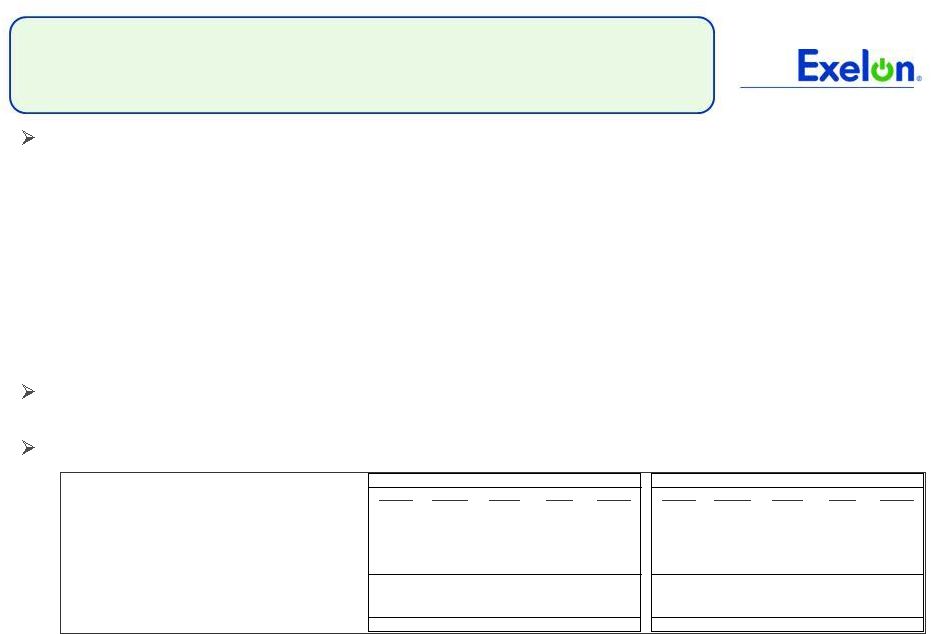 47
GAAP to Operating Adjustments
Exelon’s 2011 adjusted (non-GAAP) operating earnings outlook excludes the
earnings effects of the following:
•
Mark-to-market adjustments from economic hedging activities
•
Unrealized gains and losses from nuclear decommissioning trust fund investments to
the extent not offset by contractual accounting as described in the notes
to the consolidated financial statements •
Significant impairments of assets, including goodwill
•
Changes in decommissioning obligation estimates
•
Costs associated with ComEd’s 2007 settlement with the City of Chicago
•
Financial impacts associated with the planned retirement of fossil generating
units •
Other unusual items
•
Significant changes to GAAP
Operating earnings guidance assumes normal weather for full year
O&M reconciliation:
2010
2011
ExGen
ComEd
PECO
Other
Exelon
ExGen
ComEd
PECO
Other
Exelon
Operating and maintenance (GAAP)
2,812
1,069
733
(14)
4,600
3,010
1,220
820
(10)
5,040
JDR acquisition costs
(11)
-
-
-
(11)
-
-
-
-
-
Retirement of fossil generating units
(3)
-
-
-
(3)
(30)
-
-
-
(30)
Non-cash charge resulting from health care legislation
(4)
(3)
(2)
8
(1)
-
-
-
-
-
Asset retirement obligation reduction
-
10
1
-
11
-
-
-
-
-
Adjusted Non-GAAP O&M
2,794
1,076
732
(6)
4,596
2,980
1,220
820
(10)
5,010
Decommissioning accretion
(57)
-
-
-
(57)
(70)
-
-
-
(70)
Regulatory required programs
-
(94)
(53)
-
(147)
-
(150)
(110)
-
(260)
Operating O&M (as shown on slide 7)
2,737
982
679
(6)
4,392
2,910
1,070
710
(10)
4,680
($ millions) |
